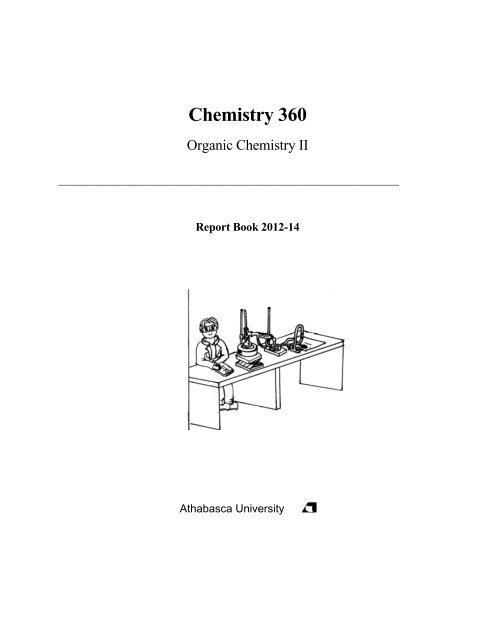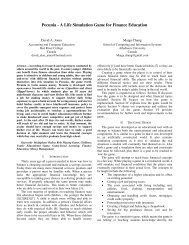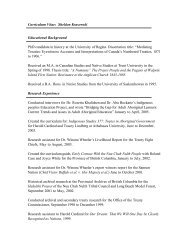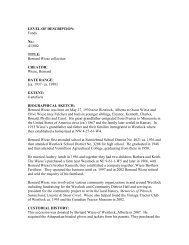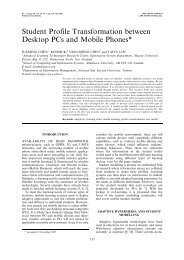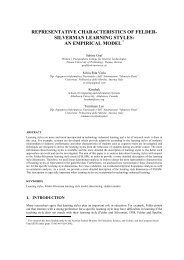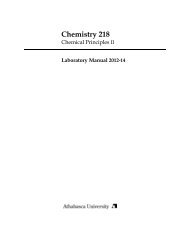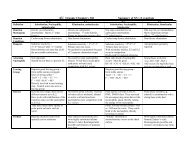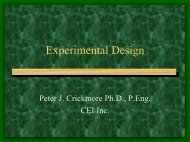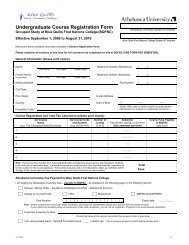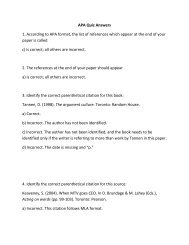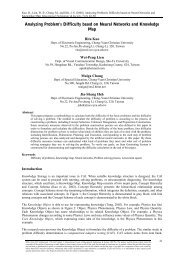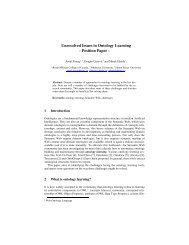You also want an ePaper? Increase the reach of your titles
YUMPU automatically turns print PDFs into web optimized ePapers that Google loves.
<strong>Chemistry</strong> <strong>360</strong>Organic <strong>Chemistry</strong> II________________________________________________________________________Report Book 2012-14<strong>Athabasca</strong> <strong>University</strong>
Course teamReport Book Authors: Dr. Lawton Shaw, Dr. Scott McGavin, Mr. Robert D.Carmichael, and Dr. Lois M. BrowneReport Book Contributors:Course Professor:Ms. Aimee CaouetteDr. Lawton ShawEvery effort has been taken to ensure that these materials comply with therequirements of copyright clearances and appropriate credits. <strong>Athabasca</strong> <strong>University</strong>will attempt to incorporate in future printings any corrections which arecommunicated to it.The inclusion of any material in this publication is strictly in accord with theconsents obtained and <strong>Athabasca</strong> <strong>University</strong> does not authorize or license anyfurther reproduction or use without the consent of the copyright holder. <strong>Athabasca</strong><strong>University</strong> students are allowed to make print copies of this document.© <strong>Athabasca</strong> <strong>University</strong> 2005, 2006, 2009, 2012All rights reservedPrinted in Canadaii
CHEM <strong>360</strong> Report Book Contents_______________________________________________________________________________General Introduction 1Report Book Structure 3Acknowledgements 4Experiment 10 Fisher Esterification Reaction 5Pre-lab Questions 5Experiment 10 Lab Report 7-15Experiment 11 Reactions of Common Functional Groups: 16Part II: Alcohols and Aryl HalidesPre-lab Questions 16Experiment 11 Lab Report 18-24Experiment 12 Reduction of Benzophenone 25Pre-lab Questions 25Experiment 12 Lab Report 27-35Experiment 13 Aldol Condensations 36Pre-lab Questions 36Experiment 13 Lab Report 38-46Experiment 14 1 H-NMR Tutorial 47Pre-lab Questions 47Experiment 14 Lab Report 50Experiment 15 Reactions of Common Functional Groups 51Part III: Aldehydes and KetonesPre-lab Questions 51Experiment 15 Lab Report 53-60iii
CHEM <strong>360</strong> Report Book Contents (cont.)_______________________________________________________________________________Experiment 16 Grignard Reaction 61Pre-lab Questions 61Experiment 16 Lab Report 63-73Experiment 17 Multi-step Synthesis of Benzocaine 74Pre-lab Questions 74Experiment 17 Lab Report 76-89Table of Reagents 90iv
CHEM<strong>360</strong> Report Book 2012-14IntroductionWelcome to Organic <strong>Chemistry</strong> <strong>360</strong>’s Laboratory Report WorkbookThis Report Book, along with the '<strong>Chemistry</strong> <strong>360</strong> Lab Manual', will help you prepare for four-five daysstraight of supervised lab instruction. All preparatory work in this report book (~12 h to finish, see liston page 3), may be completed and shown to the <strong>Chemistry</strong> Lab Co-ordinator / Lab Instructor prior tobeginning the labs.In order to successfully complete the laboratorycomponent, please be aware of the following 4 stepprocess of instruction. It is the intention of thisChem<strong>360</strong> Report Workbook to provide you with themeans of completing all four steps.Step 1: First we tell you what you are going to do.Find out by reading the lab manual, doing the pre-labquestions in this report book, and filling out the Tableof Reagents etc., i.e., preparing for the labs at home.(By doing so you are able to work more efficiently inthe lab and the over-all time spent in the supervisedlab can be the usual 32 hours.)Step 2: Next we show you how to do it.When you come to the lab, a lab instructor willgive a safety orientation, followed by a seriesof mini lab lectures on each experiment.Various techniques will be demonstrated andyou will be shown how to handle chemicals,dispose of hazardous waste, and operate theequipment.1
CHEM<strong>360</strong> Report Book 2012-14IntroductionStep 3: Lab Time: Now you do what you've read,been told, and shown.This is the time you spend in the lab performing yourexperiments, making your products, and recordingyour results in this report workbookStep 4: Finally, you tell us what you did.This is the report writing stage. Actually most of your reports will have been written while in the lab.At home you will only have to do your calculations, write your discussion and conclusion and answerthe questions at the end of each experiment.2
CHEM<strong>360</strong> Report Book 2012-14IntroductionReport Book Structure and How to Prepare for the Labs:This CHEM<strong>360</strong> Report Book is to be used in conjunction with the CHEM<strong>360</strong> Organic <strong>Chemistry</strong> II LabManual. It consists of an Introduction, Experiment Report Forms, Table of Reagents and Unknown Spectra. The reportsare to be completed one month after of the lab session you attended. As a safety precaution, it is advisable to photocopyyour reports before mailing them to your tutor for marking. Note: the marked reports are not returned to you.How to best do the Report Book Exercises1. First read through the lab manual introduction, and then answer the pre-lab questions for each experiment.2. Complete the Objectives in the Experiment Report.3. Complete the Procedure (Refer to lab manual pages) and make a flowchart if necessary.4. Complete the Table of Reagents for each experiment (detach a copy of the TOR to avoid flipping back and forth)5. You are now ready to come to the lab and do the experimental work.Note: Each experiment in the report book has the following headings:Report Book HeadingPurpose and Use1. Experiment Prelab Questions Answer these questions to help you prepare andunderstand what you are doing in the lab. In order toanswer these questions you will have to consult theCHEM<strong>360</strong> Lab Manual, and to read the 'Introductionto Concept', and 'Background Information' sections ofthis manual.To get feedback, you may submit them to the labcoordinator before the lab session begins.*2. Objectives Lists what you should learn from the lab. (see also labmanual). Use this information to fill in 'Objectives' inyour Lab Write-up. When appropriate, write out anychemical reactions.3. Introduction Briefly state how the objectives of the experiment willbe achieved and provide the relevant backgroundinformation.4. Procedure Refer to the lab manual and only note anymodifications or changes. Fill out the Table ofReagents**. Use the flowchart procedural step table torecord your work and observations.The sections of your report shown below are completed while doing the experiment, or at home after the labsession.5. Results While doing or immediately after your experiment,record your results in this section of the report.6. Discussion and Conclusion As soon after the lab as possible, discuss your resultsin light of the objectives, and make the appropriateconclusions. Remember to discuss sources of potentialerror and loss.7. Post Lab Questions Answer these questions to prove you understand whatyou did in the lab. To be completed after theexperiment is finished. Submit your answers by mailalong with the Course Evaluation.*CHEM<strong>360</strong> Prelab questions will soon be available online at: http://science.pc.athabascau.ca/chem<strong>360</strong>.nsf**CHEM<strong>360</strong> Reagents is available online at: http://science.pc.athabascau.ca/chem<strong>360</strong>.nsf3
CHEM<strong>360</strong> Report Book 2012-14IntroductionAcknowledgements:The authors wish to especially thank Ms. Aimee Caouette for all the artwork. <strong>Athabasca</strong> <strong>University</strong> alsowishes to thank Drs. K. Tanabe and T. Tamura and for their permission to use the IR and 1H-NMR Spectra used in ourlab manual and report book (pp. 15, 35, 46, 60, and 73). They were obtained from the SDBS web site:http://www.aist.go.jp/RIODB/SDBS/.Each experiment in CHEM<strong>360</strong> has been modified and rewritten from other sources, keeping the particularneeds of <strong>Athabasca</strong> <strong>University</strong> students in mind. The format of this Report Book have been checked in our <strong>Athabasca</strong>laboratories by Dr. Lawton Shaw, Klaus Thomson, Nyron Jaleel, and Robert Carmichael. Special thanks to Ms. AimeeCaouette for her help on the Infrared Tutorial (Summer 1999). Also thanks to Mr. Douglas Woudstra and Mr. JamesTaylor (CHEM<strong>360</strong> students 2004-05) for their helpful suggestions to improve the report book. The comments andsuggestions received from all the individuals mentioned above were greatly appreciated by the Course Co-ordinator.The following sources are also hereby acknowledged:L.M. Browne, 2005. Laboratory Report Book, <strong>Chemistry</strong> 161, <strong>University</strong> of Alberta.L.M. Browne, 2005. Laboratory Report Book, <strong>Chemistry</strong> 163, <strong>University</strong> of Alberta.Lehman, J.W. 1999. Operation Organic <strong>Chemistry</strong>: A Problem-Solving Approach to the Laboratory Course, 3 rd ed.,Prentice Hall, New Jersey.Mayo, D.W., R.M. Pike, and S.S. Butcher. 1989. Microscale Organic Laboratory, 2nd ed., John Wiley and Sons,Toronto, pp.229-232.McMurry, J., 1992. Organic <strong>Chemistry</strong>, 3 rd ed., Brooks/Cole Publishing Company, Pacific Grove, CA.Weast, R.C. et al, 1974. CRC Handbook of <strong>Chemistry</strong> and Physics, 65 th ed., CRC Press, Inc., Boca Raton, FL.4
CHEM<strong>360</strong> Report Book 2012-14Exp.10CHEM<strong>360</strong> Experiment 10 ReportStudent Name:___________________Date:___________ID Number:___________Experiment 10 Prelab Questions:Lab Safety1. What are the hazards of working with concentrated acids like glacial acetic acid and sulfuric acid?a) They are both extremely flammableb) They are only mildly corrosive and no significant precautions are neededc) Boiling these highly corrosive acids increases the danger to the experimenter, especially if thereaction flask should crack and break during heatingEquipment Preparation2. Why must the condenser be ‘clean and dry’ prior to use?a) Clean and dry glassware automatically guarantees a higher yieldb) Water is a by-product of the reaction and having ‘wet glassware’ will slow the reaction downc) Chemists are just neat3. The following diagram for the ‘reflux apparatus’ used in Experiment 10 is correctly labelled.a) Trueb) false5
CHEM<strong>360</strong> Report Book 2012-14Exp.10Reagent Preparation4. What are the two starting reagents used in a Fisher Esterification?a) carboxylic acid and a ketoneb) alcohol and an esterc) alcohol and a carboxylic acidd) carboxylic acid and an esterReaction5. Is the Fisher esterification reaction reversible?a) yesb) no6. How long must you ‘reflux the reaction’ in order to maximize the amount of product formed?a) 20 min.b) 20-40 min.c) 60 min. or more (The longer the better!)7. What acts as the nucleophile (Nu), and what acts as the electrophile (E) in this reaction?a) Nu = sulphuric acid, E = acetic acidb) Nu = isoamyl alcohol, E = acetic acid (protonated form)c) Nu = isoamyl alcohol, E = acetic acidd) Nu = acetic acid, E = isoamyl acetateReaction Workup8. What gas is evolved during the reaction workup phase, when you wash the crude ester with 5%Na 2 CO 3 (Procedure step C-5)?a) H 2 (g)b) N 2 (g)c) O 2 (g)d) CO 2 (g)Product Characterization9. How is the ester product purified and characterized?a) Yield, refractive index, % yield, infrared spectral analysisb) Boiling point, refractive index, and infrared spectral analysisc) Yield, boiling point, refractive index, % yield, and infrared spectral analysis10. What major differences in absorption bands would you expect to see in the infrared spectra of isoamylalcohol, and isoamyl acetate, the ester product?a) Broad 3300 cm -1 absorption for alcohol, sharp ~1740 cm -1 C=O of carbonyl in the esterb) Sharp ~2900 cm -1 absorption(s) for sp 3 C-H, no ~2900 cm -1 absorption for sp 3 C-H in ester.c) Sharp 3300 cm -1 absorption for alcohol, broad ~1740 cm -1 C=O of carbonyl in the ester .d) Sharp ~1200 cm -1 absorption for C-O of alcohol, none for the ester6
CHEM<strong>360</strong> Report Book 2012-14Exp.10CHEM<strong>360</strong> Experiment 10 ReportStudent Name:___________________Date:___________ID Number:___________Title:Objective(s):Equation(s): (General and specific reaction, draw structures, and provide names)7
CHEM<strong>360</strong> Report Book 2012-14Exp.10Introduction:8
CHEM<strong>360</strong> Report Book 2012-14Exp.10Procedure: (Reference: use proper format. Any Changes/Modifications?)Procedure for the Fisher esterification of acetic acid with isoamyl alcohol.Procedural StepObservations/Comments/InferencesRecord amounts of reagents used.Table 10.1 Table of Reagents for Experiment 10 Fisher Esterification.Reagent Formula Mwt.(g/mol)Acetic acid, glacial (conc.)17.4 MIsoamyl alcohol(3-methyl -1-butanol)Sulfuric acid, conc.18 Md(g/ml)Mp*(C)Bp*(C)(CH 3 ) 2 CH(CH 2 ) 2 OH 88.15 130 IrritantH 2 SO 4 1.840Distilled water H 2 O 18.02 1.000 0 100 noneDiethyl etherHaz. Properties5% sodium carbonate (aq) Na 2 CO 3 (aq)Sat. sodium chloride (aq)(brine)Calcium chloride (anhydr) CaCl 2acetone, washNaCl (aq)Isoamyl acetate CH 3 CO 2 C 5 H 11 130.19 142*find and record either the melting point if the reagent is a solid at room temperature, or the boiling point if the reagent is a liquidat room temperature.9
CHEM<strong>360</strong> Report Book 2012-14Exp.10EXPERIMENT 10 FLOW CHARTREAGENT PROCEDURE / STEP OBSERVATIONAmt = _______Amt = _______Amt = _______Add dH 2 OAmt = ______Add boiling stonesReflux for 45-60 minCool, transfer to sep. fun.Add diethyl ether(ester extract’n)Amt = ____Add dH 2 O washAmt = ______5% Na 2 CO 3 washCheck pH.Amt = ____Brine washAmt = ______Add drying agentCaCl 2 (anhydr.)Distil Crude Ester(add boiling stones)10Product Characterization by: ________________
CHEM<strong>360</strong> Report Book 2012-14Exp.10Experiment 10 Results:Table 10.2. Summary Table of Observations (this table is optional. Use only to tidy up observations if necessaryfrom the previous pages. Otherwise just say “see previous pages 9-10.”):Procedural StepComment or Observation and InferenceTable 10.3. Table of Product Data for Isoamyl acetate, Fisher Esterification Product.Table 10.3. presents the summary of the results of the experiment. The calculations for limitingreagent, theoretical yield and percent yield are shown below the table. Note: _________________ was foundto be the limiting reagent.YieldMass(g)Isoamyl acetateAppearanceof LiquidBoilingPt.*(C)RefractiveIndexn D obs.RefractiveIndex^(n D 20 )TheoreticalYield(g)% Yield*Corrected for barometric pressure effects using the formula…^Corrected to 20C using the formula:Limiting Reagent and Theoretical Yield Calculation:Moles of acetic acid used in the reaction =Moles of isoamyl alcohol used in the reaction =Theoretical Yield of iosamyl acetate =% Yield Calculation:11
CHEM<strong>360</strong> Report Book 2012-14Exp.10Table 10.4.Tabulation of Characteristic Infrared Absorptions for Starting regents and Product.Table 10.4 contains the results of the Infrared Spectral Analyses for the isoamyl alcohol, acetic acid,and isoamyl acetate as obtained by thin film in a FTIR. See also attached spectra for peak numberingand identification.Isoamyl alcohol>3000 cm -1 RegionPeakCode#Wavenumber(cm -1 )Peak Shape(sharp, broad)Peak Intensity(strg,, med., or weak)Functional GroupIndicated3000-2000 cm -1 Region2000-1400 cm -1 RegionFingerprint RegionFunctional Groups Absent:Acetic acid>3000 cm -1 RegionPeakCode#Wavenumber(cm -1 )Peak Shape(sharp, broad)Peak Intensity(strg,, med., or weak)Functional GroupIndicated3000-2000 cm -1 Region2000-1400 cm -1 RegionFingerprint RegionFunctional Groups Absent:Isoamyl acetate>3000 cm -1 RegionPeakCode#Wavenumber(cm -1 )Peak Shape(sharp, broad)Peak Intensity(strg,, med., or weak)Functional GroupIndicated3000-2000 cm -1 Region2000-1400 cm -1 RegionFingerprint RegionFunctional Groups Absent:12
CHEM<strong>360</strong> Report Book 2012-14Exp.10Discussion:Comments on reasons for yield (high or low), purity (high or low), sources of error, infrared spectrum results:Conclusion:Structure of Product13
CHEM<strong>360</strong> Report Book 2012-14Exp.10Experiment 10 Post Lab Questions:1. If the cost of both the alcohol and carboxylic acid were prohibitive, how would youmaximize the yield of your Fischer esterification product while keeping costs down?2. Why did you wash your product with water (3X), before washing it with the solutionof sodium hydrogen carbonate? What was the purpose of washing with sodiumhydrogen carbonate?3. Explain the function of the acid catalyst in a Fisher esterification reaction.4. What would the reactants be to produce isoamyl valerate via Fischer esterificationreaction?14
CHEM<strong>360</strong> Report Book 2012-14Exp.10Acetic acid (thin liquid film on KBr)Isoamyl alcohol (thin liquid film on KBr)Isoamyl acetate (thin liquid film on KBr)15
CHEM<strong>360</strong> Report Book 2012-14CHEM<strong>360</strong> Experiment 11 ReportStudent Name:___________________Date:___________ID Number:___________Exp.11Experiment 11 Prelab Questions:Lab Safety1. Should you stopper the test tubes prior to heating the tubes in the Ethanolic Silver Nitrate and SodiumIodide/Acetone Tests?a) Yes. You must stopper the test tubes to prevent evaporation of the test compoundb) No. You should never heat closed vessel as it may explode!Equipment Preparation2. Should the test tubes used in this experiment be clean and dry prior to use?a) yesb) noReagent Preparation3. What oxidizing agent is used to detect primary and secondary alcohols, but not tertiary alcohols?a) sulphuric acidb) sodium dichromatec) mixture of sulphuric acid and sodium dichromated) Lucas reagent16
CHEM<strong>360</strong> Report Book 2012-14Exp.11Reaction4. What is the organic product of the reaction of Lucas reagent with an alcohol?a) ketoneb) silver halidec) waterd) alkyl halide5. What type of alcohol would be positive in both the Dichromate and Lucas Reagent tests?a. phenolb) primaryc) secondaryd) tertiary6. S N 1 stands for?a) substitution nucleophilic unimolecularb) substitution nucleophilic bimolecularc) substitution nucleophilic first7. S N 2 stands for?a) substitution nucleophilic unimolecularb) substitution nucleophilic bimolecularc) substitution nucleophilic second8. Why is the silver nitrate test a good one to observe S N 1 reaction mechanism behaviour?a) A positive reaction shows a change of color and is easily distinguished from a negative reactionb) precipitates that form are easily seen in positive testsc) the gas produced is easily seen in positive tests9. Why is the sodium iodide in acetone test a good one to observe S N 2 reaction mechanism behaviour?a) A positive reaction shows a change of color and is easily distinguished from a negative reactionb) precipitates that form are easily seen in positive testsc) the gas produced is easily seen in positive testsCleanup10. What should be done with the completed test solutions?a) they should be rinsed into the Halogentated organic waste containerb) they can be rinsed down the drainc) store them in the fumehood17
CHEM<strong>360</strong> Report Book 2012-14CHEM<strong>360</strong> Experiment 11 ReportStudent Name:___________________Date:___________ID Number:___________Exp.11Title:Objective(s):General Equation(s): (structures and names)18
CHEM<strong>360</strong> Report Book 2012-14Exp.11Procedure: (Ref:)Changes/Modifications?Table 11.1. Table of Reagents for Experiment 11.Reagent Formula Mwt. Vol/Mass d mp bp Haz. Properties1-butanol C 4 H 9 OH 74.12 4 drops 0.810 -89.5 117-118 Flamm., Irritant2-butanol C 4 H 9 OH 74.12 4 drops 0.807 100 Flamm., Irritant2-methyl-2-propanol C 4 H 9 OH 74.12 4 drops 0.7887 25.5 82.3 Flamm., IrritantCyclohexanol C 6 H 11 OH 100.16 4 drops 0.9624 25.1 161.1 Irritant, Hygroscopic1-chlorobutane C 4 H 9 Cl 92.57 8 drops 0.8862 -123 78.4 Flammable2-chlorobutane C 4 H 9 Cl 92.57 8 drops 0.8732 -131 68.2 Flammable2-chloro-2-methylpropane C 4 H 9 Cl 92.57 8 drops 0.8420 -25.4 52 Flammable1-bromobutane C 4 H 9 Br 136.9 8 drops 1.2758 -112 101.6 Flammable, Irritant2-bromobutane C 4 H 9 Br 136.9 8 drops 1.2585 -112 91.2 Flammable, IrritantChlorobenzene C 6 H 5 Cl 122.4 8 drops 1.1058 -45.6 132 Flammable, Irritantbenzyl chloride C 6 H 5 CH 2 Cl 126.59 8 drops 1.1002 -39 179.3 Toxic, Cancer susp.agent3-chloro-1-butene C 4 H 7 Cl 90.55 8 drops 0.8978 64-65 Flamm., LachrymatorBromocylclohexane C 6 H 11 Br 163.06 8 drops 1.3359 -56.5 166.2 Flammable, IrritantBromocyclopentane C 5 H 9 Br 149.04 8 drops 1.3873 136.7 Flammable, Irritant-bromostyrene C 6 H 5 CHCHBr 183.05 8 drops 1.4269 7 219 Irritantsodium dichromate Na 2 Cr 2 O 7 261.6 12 mL Toxic, Cancer susp.agentsulfuric acid H 2 SO 4 98.08 Corrosive, Toxic, OxidizerLucas reagent Solution of ZnCl 2 and HCl Toxic, Irritantzinc chloride, anhydrous ZnCl 2 136.28 2.91 283 732 Corrosive, Toxichydrochloric acid, conc. HCl 36.46 1.20 (110) Corrosive, Highly toxicsodium iodide NaI 149.9 Mosit. Sens., Irritantsilver nitrate AgNO 3 169.8 Highly toxic, Oxidizernitric acid HNO 3 63.01 1.400 Corrosive, OxidizerAcetone CH 3 COCH 3 58.09 0.818 56.5 Flammable, Irritantethanol CH 3 CH 2 OH 46.07 0.785 78.5 Flammable, Poison19
CHEM<strong>360</strong> Report Book 2012-14Exp.11Experiment 11 Part A Results: Reactions of Alcohols (1, 2, and 3)1. Alcohol Oxidation by Sodium DichromateTest Substance Observation Inference Equation1-butanol2-butanolcyclohexanol2-methyl-2-propanol2. Lucas Reagent TestTest Substance Observation Inference Equation1-butanol2-butanolcyclohexanol2-methyl-2-propanol20
CHEM<strong>360</strong> Report Book 2012-14Exp.11Experiment 11 Part B Results: Reactions of Alkyl HalidesSilver Nitrate Test (S N 1 Mechanism)Test Substance Observation Inference Equation1-chlorobutane2-chlorobutane2-chloro-2-methylpropane1-bromobutane2-bromobutaneChlorobenzeneBenzyl chloride3-chloro-1-buteneBromocyclohexaneBromocyclopentane-bromostyrene21
CHEM<strong>360</strong> Report Book 2012-14Exp.11Experiment 11 Part B Results: (cont.)Sodium Iodide/Acetone Test (S N 2 Mechanism)Test Substance Observation Inference Equation1-chlorobutane2-chlorobutane2-chloro-2-methylpropane1-bromobutane2-bromobutaneChlorobenzeneBenzyl chloride3-chloro-1-buteneBromocyclohexaneBromocyclopentane-bromostyrene22
CHEM<strong>360</strong> Report Book 2012-14Exp.11Conclusion:23
CHEM<strong>360</strong> Report Book 2012-14Exp.11Experiment 11 Post Lab Questions:1. There are four isomeric alcohols having the formula C 4 H 10 O, and in this experimentyou investigated the properties of three of them. How would you expect the fourthisomer to behave when treated with (i) acidic sodium dichromate, and (ii) Lucasreagent?2. On the basis of your results, arrange the eleven halogen-containing compounds inorder of decreasing reactivity in (i) S N 1 reactions and (ii) S N 2 reactions.3. a. What results would you expect to observe when benzyl alcohol,C 6 H 5 CH 2 OH, is treated with (i) acidic sodium dichromate, and (ii) Lucasreagent?b. What results would you expect to obtain when 1-chloro-2,2-dimethylpropaneis treated with (i) ethanolic silver nitrate, and (ii) sodium iodide in acetone?24
CHEM<strong>360</strong> Report Book 2012-14Exp.12CHEM<strong>360</strong> Experiment 12 ReportStudent Name:___________________Date:___________ID Number:___________Experiment 12 Prelab Questions:Lab Safety1. Sodium borohydride (NaBH 4 ) is much safer to use than lithium aluminium hydride (LiAlH 4 )?a) yesb) noc) This statement is false. They are both safed) This statement is false. They are both highly dangerous reagents!Equipment Preparation2. Why must you place a magnetic stir bar into the reaction vessel and use a stir plate for this reaction?a) for the reaction to occur to its fullest extent, the reagents need to be continuously mixedb) the magnetic stir bar serves as a site for crystal nucleationc) to keep the crystalline product from settling to the bottom of the flaskReagent Preparation3. Why must you prepare the two main reagents, sodium borohydride and benzophenone, separately andthen mix them together?a) as a safety precaution so as to avoid an uncontrolled premature reactionb) the two reagents are not misciblec) you can only do one thing at a time in a chemistry labReaction4. Why do you add the sodium borohydride slowly to the benzophenone?a) to avoid spilling the reagentb) sodium borohydride is very difficult to handlec) as a safety precaution; to control the rate of the exothermic reactionReaction Workup5. What is the purpose of adding the hydrochloric acid/ice in the procedure step 5?a) To dilute and lower the pH of the mixture and thereby prevent product precipitationb) To decompose the excess sodium borohydride, and protonate the alcohol moiety of the finalproductc) To prevent the decomposition of the sodium borohydride25
CHEM<strong>360</strong> Report Book 2012-14Exp.126. Should an Erelnmeyer flask be used as the vessel to recrystallize the final product, or a beaker?a) There is no advantage. Either one could be usedb) Erlenmeyer flask. The narrower neck of the Erlenmeyer flask acts like a condenser and preventsthe solvent from evaporating too quickly. Also a flask can eventually be sealed with a stopperwhile crystal growth is occurring.c) Beaker. A beaker is easier to add solvent to and the recrystallized product is easier to recoverfrom a beaker.7. Why is hexane used as the recrystallization solvent?a) because diphenylmethanol is soluble in hot hexane and insoluble in cold hexaneb) because diphenylmethanol is insoluble in hot hexane and isoluble in cold hexanec) because it is the only solvent availableProduct Characterization8. What is the purpose of performing TLC on the crude and recrystallized product, and benzophenone?a) To compare and determine the purity of the final productb) To measure the yield of the final productc) To purify the final product9. Does the TLC sketch shown here indicate the product diphenylmethanol to be pure or impure afterrecrystallization?a) pureb) impure11. What major differences in absorption bands would you expect to see in the infrared spectra ofbenzophenone, and diphenylmethanol, the alcohol product?a) sharp ~1710 cm -1 C=O of carbonyl in the ketone, broad 3300 cm -1 absorption for alcoholb) broad ~1740 cm -1 C=O of carbonyl in the ketone, sharp 3300 cm -1 absorption for alcoholc) Sharp ~1200 cm -1 absorption for C-O for the ketone, not present for the alcohol26
CHEM<strong>360</strong> Report Book 2012-14Exp.12CHEM<strong>360</strong> Experiment 12 ReportStudent Name:___________________Date:___________ID Number:___________Title:Objective(s):Reaction Equation: (structures and names)Introduction:27
CHEM<strong>360</strong> Report Book 2012-14Exp.12Procedure: (Reference format: author surname, initials, date. Title of text, publisher, pages)Any Changes/Modifications?Part A: Reduction of BenzophenoneProcedural StepPreparation of organic reagentObservations/Comments/InferencesPreparation of reducing agentPart B: Thin Layer Chromatography of Reagent and Product.Procedural Step1. Preparation of eluentObservations/Comments/Inferences2. Preparation of spotting solutions3. Number of spots per lane:4. Appearance of developed TLCTable 12.1. Table of Reagents for Exp. 12Reagent Formula Mwt. Vol/Mass d moles mp bp Haz. PropertiesBenzophenone C 6 H 5 COC 6 H 5 182.22 NA NA(or diphenylketone)Sodium borohydride NaBH 4 37.83 NA 400 NAMethanol CH 3 OH 32.04 1.3288 -93.9 65Hydrochloric acid HCl 36.46 1.20 NA(conc. = 12M)Hexane C 6 H 14 86.18 0.659 NA 69Ethyl acetate C 2 H 5 CO 2 C 2 H 5 88.11 2 mL 0.902 NA 77Ligroin Mineral spiritis 10 mL 0.656 NA 60-80Chloroform CHCl 3 119.39 3 mL 1.500 NA 61.3Iodine I 2 253.81 trace NA 133 NADiphenylmethanol(or benzhydrol)NA = not applicable? NA28
CHEM<strong>360</strong> Report Book 2012-14Exp.12SAMPLE EXPERIMENT 12 FLOW CHARTREAGENT PROCEDURE / STEP OBSERVATION_____ gSodiumborohydride25 mLErlenmeyerFlask30g iceand 3mLconc.HCl___ mLHexaneRecrystallizeProduct Characterization by: ________________29
CHEM<strong>360</strong> Report Book 2012-14Exp.12Experiment 12 Results:Table 12.2. Summary Table of Observations (this table is optional. Use only to tidy up your observations from theprevious page if necessary.):Procedural StepComment or ObservationTable 12.3. Table of Product Data for Diphenylmethanol, the Carbonyl Reduction Product.Table 12.3. presents the summary of the results of the experiment. The calculations for limitingreagent, theoretical yield and percent yield are shown below the table. Note: _________________ was foundto be the limiting reagent.Product NameYield(Mass in g)Appearanceof SolidObservedMelting Pt.*(C)Lit. MeltingPt.(C)TheoreticalYield(g)% Yield*uncalibrated thermometer used.Limiting Reagent and Theoretical Yield Calculation:Moles of benzophenone used in the reaction =Moles of sodium borohydride used in the reaction =Theoretical Yield of diphenylmethanol =% Yield Calculation:30
CHEM<strong>360</strong> Report Book 2012-14Exp.12Table 12.4. Infrared Spectrum Data Analysis (see attached spectra)AbsorptionBand#Wavenumber(cm -1 )PeakShape(sharp, broad)PeakIntensity(strong, mediumor weak)Functional GroupIndicatedFunctional Group absent:AbsorptionBand#Wavenumber(cm -1 )PeakShape(sharp, broad)PeakIntensity(strong, mediumor weak)Functional GroupIndicatedFunctional Group absent:AbsorptionBand#Wavenumber(cm -1 )PeakShape(sharp, broad)PeakIntensity(strong, mediumor weak)Functional GroupIndicatedFunctional Group absent:Fig 12.1. TLC Analysis of Benzophenone, Crude and Recrystallized Diphenylmethanol31
CHEM<strong>360</strong> Report Book 2012-14Exp.12Discussion:Comments on and reasons for yield (high/med/low), purity (high/med/low), sources of error (uncalibrated thermometer?, side reactions?):Conclusion:Structure of Product32
CHEM<strong>360</strong> Report Book 2012-14Exp.12Experiment 12 Post Lab Questions:1. Aldehydes and ketones can be reduced to alcohols using hydrogen gas and a metalcatalyst. Suggest two reasons why the use of sodium borohydride is preferred overthe catalytic hydrogenation in order to prepare diphenylmethanol frombenzophenone.2. In this experiment, you destroyed the excess sodium borohydride by reacting it withhydrochloric acid (Part A, Step 5). What gas was evolved during the process?Write a balanced equation for the reaction that occurred. (Hint: one of the productswas boric acid).33
CHEM<strong>360</strong> Report Book 2012-14Exp.12Literature Infrared Spectrum of Benzophenone (cast thin film on KBr)Literature Infrared Spectrum of Diphenylmethanol (cast thin film on KBr)34
CHEM<strong>360</strong> Report Book 2012-14Exp.13CHEM<strong>360</strong> Experiment 13 ReportStudent Name:___________________Date:___________ID Number:___________Experiment 13 Prelab QuestionsLab Safety1. What is the major danger of using 95% ethanol?a) It is corrosiveb) It is flammablec) It is an oxidizerEquipment Preparation2. A stirrer/hot plate is used in this experiment in order to:d) continuously mix the reagents and allow the reaction to occur to its fullest extente) the magnetic stir bar serves as a site for crystal nucleationf) to keep the crystalline product from settling to the bottom of the flaskReagent Preparation3. How do you use the molar mass (MM, g/mol) and density (d, g/mL) of your starting aldehyde orketone to determine the volume amount of reagent to add (mL) to the reaction, from knowing only thenumber of moles to use?a) Moles reagent to use is divided by the MM = grams reagent, divided by the density = mL ofreagent to use, i.e., (mol / MM)/d = mLb) Moles reagent to use multiplied by the MM = grams reagent, divided by the density = mL ofreagent to use, i.e., (mol MM)/d = mLc) Moles reagent to use divided by the MM = grams of reagent, multiplied by the density = mL ofreagent to use, i.e., (mol /MM) d = mL4. What is the purpose of adding the reagent 95% ethanol (in water) to the reaction mixture of the ketoneand aldehyde?a) 95% ethanol is the solvent for the reactionb) 95% ethanol prevents unwanted side reactionsc) 95% ethanol reacts with sodium hydroxide to form sodium ethoxide, which is the base catalystfor the reactionReaction5. The aldol condensation is used by synthetic chemists:a) because it is a reversible reactionb) because it is non-reversible reactionc) to form a new carbon-carbon bondReaction Workup6. Will your product be essentially pure after cooling the flask in ice in Step 2 of the procedure?a) yesb) no36
CHEM<strong>360</strong> Report Book 2012-14Exp.137. Will your product be essentially pure after washing your product with ice cold 95% ethanol, ice cold95% ethanol + 4% acetic acid and again with ice cold 95% ethanol in Step 3 of the procedure?a) yesb) no8. Why must the washing solutions be ice-cold in Step 3 of the procedure?a) to prevent dissolving the product, which is more soluble in warm solvent than coldb) to keep the reaction from warming upc) to prevent unwanted side reactions9. How will you know which solvent (95% ethanol or toluene) is more suitable for the recrystallizationof your product?a) the chosen solvent will dissolve less crystals when hot, and form more crystals when coldb) the chosen solvent will dissolve more crystals when hot, and form more crystals when coldc) the chosen solvent will dissolve less crystals when hot, and form less crystals when coldProduct Characterization10. What reason(s) may help to explain a low percentage yield for your aldol condensation reactiona) the reagents where incorrectly measuredb) all the washing steps resulted in the loss of some product, even when ice cold solvents were usedc) the chosen recrystallization solvent still kept some of the product dissolvedd) all of the above37
CHEM<strong>360</strong> Report Book 2012-14Exp.13CHEM<strong>360</strong> Experiment 13 ReportStudent Name:___________________Date:___________ID Number:___________Title:Objective(s):Reaction Equation: (structures and names)Introduction:38
CHEM<strong>360</strong> Report Book 2012-14Exp.13Introduction: (cont.)39
CHEM<strong>360</strong> Report Book 2012-14Exp.13Procedure: (Reference: author surname, initials, date. Title of text, publisher, pages)Any Changes/Modifications?Mixed Aldol Condensation Reaction ObservationsProcedural StepObservations/Comments/InferencesTable 13.1. Table of Reagents for Exp. 13Reagent Formula Mwt. d mp bp Haz. PropertiesBenzaldehyde 1.044 179.54-methylbenzaldehyde CH 3 C 6 H 4 CHO 1.019 204-2054-methoxybenzaldehyde CH 3 OC 6 H 4 CHO 1.119 248Cinnamaldehyde C 6 H 5 CH=CHCHO 1.048 248Acetone CH 3 COCH 3 0.818 56.5Cyclopentanone C 5 H 8 O 0.951 130.6Cyclohexanone C 6 H 10 O 0.947 1554-methylcyclohexanone CH 3 C 6 H 9 O 0.914 169-171Ethanol CH 3 CH 2 OH 0.785 78.5Sodium hydroxide NaOH (1M) ~1.00Acetic acid CH 3 COOH 1.049 118.1Toluene C 6 H 5 CH 3 0.865 110.6Benzalacetone C 6 H 5 CHCHCOCH 3DibenzalacetoneDibenzalcyclohexanoneDibenzalcyclopentanoneChloroform CHCl 3Carbon tetrachloride CCl 440
CHEM<strong>360</strong> Report Book 2012-14Exp.13SAMPLE EXPERIMENT 13 FLOW CHARTREAGENT PROCEDURE / STEP OBSERVATION10 mL95%ethanol10 mL95%EtOH +4% Acetic acid10 mL95%ethanolSelect Solvent=______________Recrystallize fromProduct Characterization by:Experiment 13 Results:41
CHEM<strong>360</strong> Report Book 2012-14Exp.13Table 13.2. Summary Table of Observations (this table is optional. Use only to tidy up your observations from theprevious page if necessary.):Procedural StepComment/Observation/InferencesTable 13.3. Table of Data for Aldol Condensation Product.Table 13.3 presents the summary of the results of the experiment. The calculations for limiting reagent,theoretical yield and percent yield are shown below the table. Note: Both reagents are added in equalstoichiometric amounts. The _______________________ was used as the limiting reagent as it is a 1:1 ratiowith the product.Product NameYieldMass(g)Appearance ofSolidMeltingPt.*(C)LiteratureMelting Pt.(C)TheoreticalYield(g)% Yield*Uncorrected for temperature calibrationLimiting Reagent and Theoretical Yield Calculation:Moles of ketone actually used in the reaction =Moles of aldehyde actually used in the reaction =Theoretical Yield of Aldol product =% Yield Calculation:42
CHEM<strong>360</strong> Report Book 2012-14Table 4. Infrared Spectrum Data Analysis (see attached spectra)Aldehyde =Absorption Wavenumber PeakBand# (cm -1 ) Shape(sharp, broad)PeakIntensity(strong, mediumor weak)Exp.13Functional GroupIndicatedFunctional Group absent:Ketone =AbsorptionBand#Wavenumber(cm -1 )PeakShape(sharp, broad)PeakIntensity(strong, mediumor weak)Functional GroupIndicatedFunctional Group absent:Aldol Product =AbsorptionBand#Wavenumber(cm -1 )PeakShape(sharp, broad)PeakIntensity(strong, mediumor weak)Functional GroupIndicatedFunctional Group absent:43
CHEM<strong>360</strong> Report Book 2012-14Exp.13Discussion:Comments on and give reasons for high or low yield and purity, and sources of error (practical and theoretical), etc.:Conclusion:Structure of Product44
CHEM<strong>360</strong> Report Book 2012-14Exp.13Experiment 13 Post Lab Questions:1. The product obtained in this experiment results from a crossed condensationbetween an aldehyde and a ketone. Identify two other base-initiated reactions thatcould conceivably occur involving either or both of these reactants. Suggest reasonswhy these reactions do not result in the formation of large quantities of by-products.2. What is the purpose of adding sodium hydroxide to the reaction mixture? (useequations if necessary to explain your answer).45
CHEM<strong>360</strong> Report Book 2012-14Literature Infrared Spectrum of BenzaldehydeExp.13Literature Infrared Spectrum of AcetoneLiterature Infrared Spectrum of Dibenzalacetone (cast thin film on KBr)46
CHEM<strong>360</strong> Report Book 2012-14CHEM<strong>360</strong> Experiment 14 ReportStudent Name:___________________Date:___________ID #:___________Exp.14Experiment 14 Prelab Questions:1.1 H-NMR is an abbreviation meaning:a) nuclear magnetic resonance spectroscopyb) proton nuclear magnetic resonance spectroscopyc) carbon 13 nuclear magnetic resonance spectroscopy2. What types of information are to be found in a 1 H-NMR spectrum?a) chemical shift and multiplicity (splitting patterns)b) chemical shift, number of equivalent hydrogens, and the multiplicityc) chemical shift, number of equivalent hydrogens, multiplicity, and the number of neighbouringhydrogensd) chemical shift, number of equivalent hydrogens, multiplicity, the number of neighbouringhydrogens, and the potential signal assignment (after consulting the Shifts for Various FunctionalGroups table.3. If you know the chemical formula of your unknown, the ‘degrees of unsaturation’ calculation (degUnsaturation . = nC + 1 +1/2N -1/2nH -1/2nX) helps you to:a) determine the number of ‘equivalent double bonds’ present in your unknown (e.g., alkene = 1,alkyne = 2, cylcoalkane = 1, benzene ring = 4)b) determine the functional groups present in the unknownc) determine the structure of your unknown4. Chemical shifts are the result of ‘shielding’ and ‘deshielding’ in the environment the proton findsaround it.a) trueb) false5. The N=n+1 rule is used to determine the number of neighbouring Ha) trueb) false6. What is the purpose of adding tetramethylsilane (TMS) to a 1 H-NMR sample prior to determining itsspectrum?a) to give an example of a highly shielded hydrogen environmentb) to serve as a reference standardc) to serve as a blank47
CHEM<strong>360</strong> Report Book 2012-14Exp.147. A very common splitting pattern seen in a 1 H-NMR spectrum (see Unknown X spectrum below) is the‘2H quartet coupled to a 3H triplet’. Which of the following molecular fragments does this represent?a. a methyl groupb. an ethyl groupc. an isopropyl groupd. a tert-butyl group1 H-NMR spectrum for Unknown X showing a ‘2H quartet coupled to a 3H triplet’8. Another very common splitting pattern seen in a 1 H-NMR spectrum (see Unknown Y spectrumbelow) is a ‘1H septet coupled to a 6H doublet’. Which of the following molecular fragments doesthis usually represent?a) a methyl groupb) an ethyl groupc) an isopropyl groupd) a tert-butyl group1 H-NMR spectrum for Unknown Y showing a ‘1H septet coupled to a 6H doublet’ (ignore the singletalso shown in this example)48
CHEM<strong>360</strong> Report Book 2012-14Exp.149. The following 1 H-NMR spectrum for Unknown Z shows Unknown Z to have an aromatic ring.a) trueb) false1 H-NMR spectrum for Unknown Z10. The hardest part in determining the structure of an unknown from your NMR data, is usually the finalassembly of all the fragments.a) trueb) false49
CHEM<strong>360</strong> Report Book 2012-14CHEM<strong>360</strong> Experiment 14 ReportStudent Name:___________________Date:___________ID Number:___________Exp.14Title:Objective(s):Procedure:(Ref: )Changes/Modification:ATTACH YOUR 4 UNKNOWN IR/NMR SPECTRA PROBLEMS TO THIS TITLE PAGE.50
CHEM<strong>360</strong> Report Book 2012-14Exp.15CHEM<strong>360</strong> Experiment 15 ReportStudent Name:___________________Date:___________ID Number:___________Experiment 15 Prelab QuestionsLab Safety1. What danger exists with the Tollen’s reagent?a) The silver mirror that forms is high reflective to lightb) ammonia used is very corrosivec) Tollen’s reagent decomposes on standing to an explosive substanceEquipment Preparation2. Test tube size is very important in performing functional group tests?a) true. The test tube must not become so filled with reagent and test substance, that it becomesdifficult to mixb) true. The test tube must be completely filled with the reagent and test substance, so that it canonly be mixed by stoppering and inverting the test tubec) falseReagent Preparation3. What should the Tollen’s reagent appear like after the addition of the 1.0 M ammonium hydroxide?a) a brownish colored precipitate in solutionb) a silver colored solutionc) a clear and colorless solutionReaction(s)4. What does the Brady’s Test detect?a) methyl ketone groups in aldehydes and ketonesb) carbonyl groups of aldehydes and ketonesc) aldehydes onlyd) ketones only5. What does the Tollens’ Test detect?a) methyl ketone groups of aldehydes and ketonesb) carbonyl groups of aldehydes and ketonesc) aldehydes onlyd) ketones only6. What does the Schiff’s Test detect?a) methyl ketone groups of aldehydes and ketonesb) carbonyl groups of aldehydes and ketonesc) aldehydes and aldehyde impurities mostlyd) ketones only51
CHEM<strong>360</strong> Report Book 2012-14Exp.157. What does the Iodoform Test Detect?a) methyl ketone groups of aldehydes and ketonesb) carbonyl groups of aldehydes and ketonesc) aldehydes onlyd) ketones only8. Which of the following compounds gives a positive reaction to Brady’s, Tollens’, and Schiff’s Testsabove?a) benzaldehydeb) cylcopentanonec) acetone9. Of the following compounds, which does not react in any of the four above tests (Brady’s, Tollens’,Schiff’s, and Iodoform Tests):a) an ethyl ketoneb) cinnamaldehydec) ethyl benzoated) cyclohexanone10. What must be done to the unused Tollens’ reagent and any unreacted Tollens’ test samples:a) rinse the reagent into the General Organic waste containerb) dilute with waterc) add concentrated nitric acid to decompose the Tollens’ reagentd) leave reagent in the hood for someone else to find52
CHEM<strong>360</strong> Report Book 2012-14Exp.15CHEM<strong>360</strong> Experiment 15 ReportStudent Name:___________________Date:___________ID Number:___________Title:Objective(s):Reaction Equations:53
CHEM<strong>360</strong> Report Book 2012-14Exp.15Introduction:54
CHEM<strong>360</strong> Report Book 2012-14Exp.15Procedure:(Ref: )Changes/Modification:Table 15.1. Table of Reagents for Experiment 15.Reagent Formula Mwt. d mp bp Haz. PropertiesBenzaldehyde C 6 H 5 CHO 106.12 1.044 -26 179.54-methylbenzaldehyde CH 3 C 6 H 4 CHO 120.15 1.019 204-2054-methoxybenzaldehyde CH 3 OC 6 H 4 CHO 136.15 1.119 -1 248trans-cinnamaldehyde C 6 H 5 CHCHCHO 132.16 1.048 248Acetone CH 3 COCH 3 58.08 0.791 -94 56Cyclopentanone C 5 H 8 (=O) 84.12 0.951 -51 130-131Cyclohexanone C 6 H 10 (=O) 98.15 0.947 -47 1554-methylcyclohexanone CH 3 C 6 H 9 (=O) 112.17 0.914 169-171Formaldehyde HCHO 30.03 1.083Acetophenone C 6 H 5 COCH 3 120.15 1.030 19-20 2021-butanol CH 3 (CH 2 ) 3 OH 74.12 0.810 -90 117.72-butanol C 2 H 5 CH(OH)CH 3 74.12 0.807 99-100Methanol CH 3 OH 32.04 0.791 -98 64.7Brady's Reagent Solution See hydrazine, 2,4-dinitrophenyl2,4-dinitrophenyl hydrazine (O 2 N) 2 C 6 H 3 NHNH 2 198.14Sulfuric acid, conc. (18 M) H 2 SO 4 98.08 1.840Ethanol, 95% CH 3 CH 2 OH 46.07 0.785 78.5Tollen's Reagent Solution See ammonia + silver nitrateSchiff's Reagent Solution mixture of roseaniline hydrochloride and sulfur dioxide, ToxicAmmonium hydroxide NH 4 OH 35.05 0.90Silver nitrate AgNO 3 , 0.3 M 169.87 4.352 212Nitric acid HNO 3 63.01Sodium hydroxide NaOH, 3 M 40.00 ~1.00Iodine in potassium iodideI 2 in KI55
CHEM<strong>360</strong> Report Book 2012-14Exp.15Experiment 15 Part A Results:Brady’s Test 2,4-dinitrophenylhydrazineTest Substance Observation Inference EquationAldehyde =Ketone =Positive controlNegative controlPart B Results:Tollen’s Test - Silver MirrorTest Substance Observation Inference EquationAldehyde =Ketone =Positive controlNegative control56
CHEM<strong>360</strong> Report Book 2012-14Exp.15Part C Results:Schiff’s TestTest Substance Observation Inference EquationFormaldehydeAldehyde =Ketone =Iodoform TestTest Substance Observation Inference EquationAcetoneCyclohexanoneAcetophenone1 butanol2-butanol57
CHEM<strong>360</strong> Report Book 2012-14Exp.15Conclusion:Comments on tests, sources of error, and false positives/negatives:58
CHEM<strong>360</strong> Report Book 2012-14Exp.15Experiment 15 Post Lab Questions:1. Write a balanced equation for the reaction of acetaldehyde (i.e. ethanal) withammoniacal silver nitrate. Remember that this is a redox reaction.2. Outline a systematic functional group test procedure that would enable you todistinguish among hexanal, 2-hexanone, 3-hexanone, 2-hexanol, and cyclohexanol.3. Aldehydes and ketones can also be easily distinguished by their infrared spectra andtheir identity deduced from their 1 H-NMR spectra. Explain why this is.4. From the following results, identify the unknown compounds.a) Compound A: 2,4-DNPH positive, Tollens Test positive, Schiff's testpositive, Iodoform negative (see Spectrum (A) next page).b) Compound B: 2,4-DNPH positive, Tollens Test negative, Schiff's testnegative, Iodoform positive (see Spectrum (B) next page).59
CHEM<strong>360</strong> Report Book 2012-14Exp.15Spectrum (A): 1 H-NMR, 400 MHz in CDCl 3Molecular Formula C 8 H 8 O 2 , 9.9 = 1H, 7.8 = 2H, 7.0 = 2H, 3.9 = 3H.Spectrum (B): 1 H-NMR, 90 MHz in CDCl 3Molecular Formula C 8 H 8 O , 7.9 = 2H, 7.3-7.7 = 3H, 2.6 = 3H.60
CHEM<strong>360</strong> Report Book 2012-14Exp.16CHEM<strong>360</strong> Experiment 16 ReportStudent Name:___________________Date:___________ID Number:___________Experiment 16 Prelab QuestionsLab Safety1. A procedureal flowchart is highly recommended for performing this experiment.a) trueb) false2. No source of flame is allowed in this experiment because of the use of diethyl ether.a) trueb) falseEquipment Preparation3. Dry glassware is essential for the Grignard reaction to work because:a) the Grignard reaction is easily contaminated with waterb) the Grignard reagent is very moisture sensitivec) the Grignard reagent is very stableReagent Preparation4. What is the purpose of the magnesium and diethyl ether used in the Grignard Reaction?a) magnesium reacts with bromobenzene to form the alcohol product, triphenylmethanol, anddiethyl ether is the solvent which keeps the product in solutionb) magnesium reacts with ethyl benzoate to form the Grignard reagent, and diethyl ether is thesolvent for the reaction, which also helps to stabilize the Grignard reagentc) magnesium reacts with bromobenzene to form the Grignard reagent, and diethyl ether is thesolvent for the reaction, which also helps to stabilize the Grignard reagentReaction5. Which of the following are the limitations of the Grignard Reaction?a) the Grignard reagent is only useful in preparing tertiary alcohols, and it is moisture sensitiveb) the Grignard reagent can only be formed from certain organohalides, and it is moisture, andoxygen sensitivec) the Grignard reagent can only be formed from certain organohalides, and it is oxygen sensitiveReaction Workup6. What is the purpose of using 50mL 2M H 2 SO 4 in Part C Step 1?a) To dilute and lower the pH of the mixture and thereby prevent product precipitationb) To protonate the alcohol moiety of the final productc) To prevent the decomposition of the Grignard reagent7. What layer will your product be in after addition of the diethyl ether in Part C Step 3?a) the aqueous layerb) the ether layer61
CHEM<strong>360</strong> Report Book 2012-14Exp.168. What is the purpose of washing the organic layer with water in Part C Step 6?a) to remove water soluble impuritiesb) to remove organic impuritiesc) to extract the product into the aqueous layerd) to ‘pre-dry’ the organic layer, thereby removing the bulk of the water from the ether9. What is the purpose of washing the organic layer with brine in the same Part C Step 6?a) To remove water soluble impuritiesb) To remove organic impuritiesc) To ‘pre-dry’ the organic layer, thereby removing the bulk of the water from the etherd) To remove all water from the organic layerProduct Characterization10. What is the Retention Factor or R f of pure biphenyl in Lane D in the TLC sketch shown below:a) 1.54b) 0.65c) 0.154d) 0.06562
CHEM<strong>360</strong> Report Book 2012-14Exp.16CHEM<strong>360</strong> Experiment 16 ReportStudent Name:___________________Date:___________ID Number:___________Title:Objective(s):Reaction Equation(s):63
CHEM<strong>360</strong> Report Book 2012-14Exp.16Introduction:64
CHEM<strong>360</strong> Report Book 2012-14Exp.16Procedure:(Ref: )Changes/Modification:A. Procedure for formation of Grignard Reagent.Procedural StepObservations/Comments/InferencesB. Procedure for the reaction of the Grignard Reagent with ethyl benzoate to formTiphenylmethanol.Procedural StepObservations/Comments/InferencesC. Procedure for isolation of Triphenylmethanol.Procedural StepObservations/Comments/InferencesD. Procedure for the observation of the carbocation.65
CHEM<strong>360</strong> Report Book 2012-14Exp.16Procedural StepObservations/Comments/InferencesE. Procedure for assessment of product purity by Thin Layer Chromatography.Procedural StepObservations/Comments/Inferences66
CHEM<strong>360</strong> Report Book 2012-14Exp.16Procedure: (cont.)Table 16.1. Table of Reagents for Experiment 16.Reagent Formula Mwt. d mp bp Haz. PropertiesBromobenzeneC 6 H 5 BrMagnesium 24.31 1.75 649 1090Ethyl benzoate C 6 H 5 CO 2 C 2 H 5Diethyl ether C 2 H 5 OC 2 H 5 74.12 0.7138 -116 34.5Sulfuric acid, 2M 98.07Sodium H carbonate 84.01 2.159 270Sodium sulfate, anhyd 142.04 2.68Dichloromethane 84.93 1.325 -95.1 40.1Biphenyl (C 6 H 5 ) 2 154.21 0.992 71 255.9Ligroin(high bp pet. ether)0.656 60-80alkane mixt.Iodine 253.8 4.930 133Methanol CH 3 OH 32.04 0.7914 -94 65Ethanol C 2 H 5 OH 46.07 0.7893 -117 78.5Triphenylmethanol(C 6 H 5 ) 3 COH67
CHEM<strong>360</strong> Report Book 2012-14Exp.16SAMPLE EXPERIMENT 16 FLOW CHART Part AREAGENT PROCEDURE / STEP OBSERVATIONDry all glassware___g Mg (s)___ mLdiethyl ether___ molbromobenzene___ mLdiethyl etherKeep warm andreflux for a further20-30 min.Proceed to Part B68
CHEM<strong>360</strong> Report Book 2012-14Exp.16SAMPLE EXPERIMENT 16 FLOW CHART Part B and CREAGENT PROCEDURE / STEP OBSERVATION69
CHEM<strong>360</strong> Report Book 2012-14Exp.16Experiment 16 Results:Table 16.2. Summary Table of Observations (this table is optional. Use only to tidy up your observations from theprevious page if necessary.):Procedural StepComment or ObservationTable 16.3. Table of Product Data for Triphenylmethanol, the Grignard Reaction Product.Table 16.3. presents the summary of the results of the experiment. The calculations for limitingreagent, theoretical yield and percent yield are shown below the table. Note: _________________ was foundto be the limiting reagent.Product NameYield(Mass in g)Appearanceof SolidObservedMelting Pt.*(C)Lit. MeltingPt.(C)TheoreticalYield(g)% Yield*uncalibrated thermometer used.Limiting Reagent and Theoretical Yield Calculation:Moles of magnesium used in the reaction =Moles of bromobenzene used in the reaction =Moles of ethyl benzoate used in the reaction =Theoretical Yield of triphenylmethanol =% Yield Calculation:70
CHEM<strong>360</strong> Report Book 2012-14Exp.16Fig 16.1. TLC Analysis of Biphenyl, Mother Liquor, Crude and Recrystallized TriphenylmethanolLane#Dist to CenterSpot ( )Dist to SolventFront ( )Rf71
CHEM<strong>360</strong> Report Book 2012-14Exp.16Discussion:Comments on and reasons for yield (high/med/low), purity (high/med/low), sources of error, etc.:Conclusion:Structure of Product72
CHEM<strong>360</strong> Report Book 2012-14Exp.16Experiment 16 Post Lab Questions:1. How do you account for the fact that biphenyl is formed as a by-product in thisreaction?2. Why do you think that reactions involving Grignard reagents are sometimes carriedout in an atmosphere of nitrogen or argon?3. A Grignard reaction was performed and the following 1 H-NMR (90 MHz in CDCl 3 )was obtained of the purified product. Deduce the product's structure (MolecularFormula = C 7 H 6 O 2 ). Also write the overall reaction for its formation from anyorganohalide and carbonyl compound.1 H-NMR Spectral Data:Signal # Shift Integrat'n Splitting Comment #Neighbour H Signal Assignment1 7.5 3H2 8.1 2H3 12.1 1H Xchngs with D 2 O73
CHEM<strong>360</strong> Report Book 2012-14Exp.17CHEM<strong>360</strong> Experiment 17 ReportStudent Name:___________________Date:___________ID Number:___________Experiment 17 Prelab QuestionsLab Safety1. In Part A, the reduction of 4-nitrotoluene, a dangerous gas, HCl, must be trapped using a:a) vacuum take off adaptorb) sodium hydroxide acid-vapour gas trapc) calcium chlorideEquipment Preparation2. In Part C, Step 8, the reaction mixture must be cooled in an ice bath prior to suction filtration because:a) the product is least soluble in ice cold waterb) it will prevent dangerous side reactions from occuringc) it will stop the reaction between sodium hydrogen sulfite and manganese dioxideReagent Preparation3. In Part C, Step 3, the reason for splitting the potassium permanganate into 10 equal portions is:a) the potassium permanganate is not very soluble in hot water and therefore cannot be all added atonceb) the potassium permanganate is to be carefully added in portions so as to control the rate of theoxidation reactionc) to test the student’s ability to follow proceduresReaction4. In Part C, the oxidation of 4’-methylacetanilide, the oxidizing agent is:a) magnesium sulphate heptahydrateb) 4’methylacetanilidec) potassium permanganated) 4-acetamidobenzoic acid5. In Part E, what is the purpose of the 100% ethanol used in Step 2.a) it is the solvent for the Fisher esterification reactionb) it is both the solvent and co-substrate for the Fisher esterification reactionc) since benzocaine is highly soluble in ethanol, it is used so that the final product will notprecipitate from the reaction mixtureReaction Workup6. In Part D, the 4-acetamidobenzoic acid is hydrolyzed by the addition of _________?a) dilute hydrochloric acidb) waterc) water and 6.0 M hydrochloric acid7. In Part D, what is hydrolyzed, i.e., what is removed from the starting reagent to form the 4-aminobenzoic acid product?a) acetic acidb) ethanolc) water74
CHEM<strong>360</strong> Report Book 2012-14Exp.178. During a reflux, what constant states are maintained while the reaction proceeds? (there are 3)a) homogeneity, temperature, and volume of the solventb) homogeneity, temperature, and volume of the starting reagentc) moles of reagent, moles of product, and temperature of the reactionProduct Characterization9. Why should you not bother to perform a melting point on 4-acetamidobenzoic acid?a) the melting point of this compound will be to low to record accuratelyb) the compound is very unstable and cannot be heatedc) the melting point of this compound will be to high to read for the thermometers provided inthis course to readd) the melting point of this compound is unknown10. If you obtained % yields of 85%, 65% and 90% in a three-step synthesis, what is the overall % yield?a) 240%b) 50%c) 145%d) 18%75
CHEM<strong>360</strong> Report Book 2012-14Exp.17CHEM<strong>360</strong> Experiment 17 ReportStudent Name:___________________Date:___________ID Number:___________Title:Objective(s):Reaction equation(s):Introduction:76
CHEM<strong>360</strong> Report Book 2012-14Exp.17Introduction (cont.):77
CHEM<strong>360</strong> Report Book 2012-14Exp.17Procedure:(Ref: )Changes/Modification:Part C. Procedure for the synthesis of 4-acetamidobenzoic acid.Procedural StepRecord amount/appearance of pure 4-methylacetanilide usedObservations/Comments/InferencesReaction/Equipment SetupReactionReaction Work-upPart D. Procedure for the synthesis of 4-aminobenzoic acid.Procedural StepRecord amount of pure 4-acetamidobenzoic acid usedObservations/Comments/InferencesReaction/Equipment SetupReactionReaction Work-upPart E. Procedure for the synthesis of benzocaine.Procedural StepRecord amount/appearance of pure p-aminobenzoic acid usedObservations/Comments/InferencesReaction/Equipment SetupReactionReaction Work-up78
CHEM<strong>360</strong> Report Book 2012-14Exp.17Table 17.1. Table of Reagents for Experiment 17Reagent Formula Mwt. d mp bp Haz. Properties4-methylacetanilidemagnesium sulfate -7H 2 OMgSO 4 -7H 2 Opotassium permanganate KMnO 4sodium hydrogen sulfite NaHSO 34-acetamidobenzoic acidhydrochloric acidHClAmmonia (conc.) NH 3acetic acid, glacial4-aminobenzoic acidEthanolsulfuric acid H 2 SO 4sodium carbonate Na 2 CO 3ethyl-4-aminobenzoate79
CHEM<strong>360</strong> Report Book 2012-14Exp.17SAMPLE EXPERIMENT 17 FLOW CHART Part CREAGENT PROCEDURE / STEP OBSERVATION80
CHEM<strong>360</strong> Report Book 2012-14Exp.17SAMPLE EXPERIMENT 17 FLOW CHART Part DREAGENT PROCEDURE / STEP OBSERVATION81
CHEM<strong>360</strong> Report Book 2012-14Exp.17SAMPLE EXPERIMENT 17 FLOW CHART Part EREAGENT PROCEDURE / STEP OBSERVATION82
CHEM<strong>360</strong> Report Book 2012-14Exp.17Experiment 17 Results:Table 17.2. Table Summarizing Observations (This table is optional. Use only to tidy up your observations fromthe previous page if necessary.:Procedural StepObservations/Comments/InferencesTable 17.3.1 Properties of the 4-methylacetanilide Oxidation Product, 4-acetamidobenzoic acidTable 17.3.1 shows a summary of the results of the 4-acetamidobenzoic acid synthesis. The calculations fortheoretical yield and percent yield are shown below the table. Note: _________________ was the limitingreagent, since the only other reagent involved in the reaction, potassium permanganate was added in excess.Name of ProductMass(g)Appearance of SolidMelting Pt.(C)TheoreticalYield (g)% YieldTheoretical Yield Calculation:% Yield Calculation:83
CHEM<strong>360</strong> Report Book 2012-14Exp.17Table 17.3.2 Properties of the 4-methylacetanilide Oxidation Product, 4-aminobenzoic acidTable 17.3.2 shows a summary of the results of the 4-aminobenzoic acid synthesis. The calculationsfor theoretical yield and percent yield are shown below the table. Note: ___________ was the limiting reagent,since the only other reagent involved in the reaction, phosphoric acid, served as a catalyst.Name of ProductMass(g)Appearance of SolidMelting Pt.(C)TheoreticalYield (g)% YieldTheoretical Yield Calculation:% Yield Calculation:84
CHEM<strong>360</strong> Report Book 2012-14Exp.17Table 17.3.3 Properties of Fisher Esterification Product, benzocaineTable 17.3.3 shows a summary of the results of the benzocaine synthesis. The calculations fortheoretical yield and percent yield are shown below the table. Note: ___________ was the limiting reagent,since the only other reagent involved in the reaction, phosphoric acid, served as a catalyst.Mass(g)Appearance of SolidMelting Pt.(C)TheoreticalYield (g)% YieldTheoretical Yield Calculation:% Yield Calculation:(Theoretical) Overall % Yield Calculation85
CHEM<strong>360</strong> Report Book 2012-14Exp.17Table 4.1 Tabulation of Characteristic Infrared and 1 H-NMR Absorptions for 4-acetamidobenzoic acid.Infrared Data:AbsorptionBand#Wavenumber(cm -1 )Peak Shape(sharp, broad)Peak Intensity(strong, med. or weak)Functional GroupIndicated> 3000 cm -1Between 3000 and 2000 cm -1Between 2000 and 1400 cm -1< 1400 cm -1Functional Group(s) absent:1 H-NMR Data:Signal # Shift Integrat'n Splitting Comment #Neighbour H Signal AssignmentTable 4.2 Tabulation of Characteristic Infrared and 1 H -NMR Absorptions for 4-aminobenzoic acid.Infrared Data:AbsorptionBand#Wavenumber(cm -1 )Peak Shape(sharp, broad)Peak Intensity(strong, med. or weak)Functional GroupIndicated> 3000 cm -1Between 3000 and 2000 cm -1Between 2000 and 1400 cm -1< 1400 cm -1Functional Group(s) absent:1 H-NMR Data:Signal # Shift Integrat'n Splitting Comment #Neighbour H Signal Assignment86
CHEM<strong>360</strong> Report Book 2012-14Exp.17Table 4.3 Tabulation of Characteristic Infrared and 1 H -NMR Absorptions for benzocaine.Infrared Data:AbsorptionBand#Wavenumber(cm -1 )Peak Shape(sharp, broad)Peak Intensity(strong, med. or weak)Functional GroupIndicated> 3000 cm -1Between 3000 and 2000 cm -1Between 2000 and 1400 cm -1< 1400 cm -1Functional Group(s) absent:1 H-NMR Data:Signal # Shift Integrat'n Splitting Comment #Neighbour H Signal Assignment87
CHEM<strong>360</strong> Report Book 2012-14Exp.17Discussion:Comments on and reasons for yield (high or low), purity (high/med/low), sources of error, overall synthesiseffectiveness, etc.Conclusion:Structure of Product88
CHEM<strong>360</strong> Report Book 2012-14Exp.17Experiment 17 Post Lab Questions:1. In Part C, what is the purpose of adding magnesium sulfate to the reaction mixture?2. In the discussion pertaining to the hydrolysis of 4-acetamidobenzoic acid, it wasargued that the presence of the electron-withdrawing carboxyl group in the paraposition could result in the occurrence of some nucleophilic displacement if thehydrolysis was carried out under acidic conditions and an elevated temperature.What would the product of such a nucleophilic displacement reaction?3. Write the balanced equation for the oxidation of 4’-methylacetanilide to 4-acetamidobenzoic acid as carried out in Part C of the synthesis.4. In Part E, what is the purpose of adding 100% ethanol to the reaction mixture? (useequations if necessary to answer this question)89
CHEM<strong>360</strong> 2012-14Table of ReagentsCompoundNameChemicalFormulaSolid (S) orLiquid (L)FormulaWeightMP or BP(C)Density(g/mL)Refract.IndexHazardousProperties*acetanilide CH 3 CONHC 6 H 5 S 135.17 113-115 Toxic, irritantacetanilide,4-methyl CH 3 CONHC 6 H 4 CH 3 S 149.19 149-151 Irritantacetanilide, p-nitro CH 3 CONHC 6 H 4 NO 2 S 180.16 216 Irritantacetanilide, o-nitro CH 3 CONHC 6 H 4 NO 2 S 180.16 94 1.419 Irritantacetanilide, m-nitro CH 3 CONHC 6 H 4 NO 2 S 180.16 154-156 Irritantacetic acid, glacial (17.4 M) CH 3 CO 2 H L 60.05 118.1 1.049 Corrosive, hygroscopicacetic acid, p-ethoxyphenyl C 2 H 5 OC 6 H 4 CH 2 CO 2 H S 180.2 87-90 Irritantacetic anhydride (CH 3 CO) 2 O L 102.09 140 1.082 1.3900 Corrosive, lachrymatoracetone CH 3 COCH 3 L 58.08 56.5 0.7899 1.3590 Flammable, irritantacetone, diethylamino (C 2 H 5 ) 2 NCH 2 COCH 3 L 129.2 64/16mm 0.832 1.4250 Irritantacetophenone C 6 H 5 COCH 3 L 120.15 202 1.030 1.5325 Irritantactivated carbon S (see charcoal)allyl alcohol (2-propen-1-ol) CH 2 =CHCH 2 OH L 58.08 96-98 0.854 1.4120 Highly Toxic, flammableammonia (14.8 M) NH 3 L 17.03 0.90 Corrosive, lachrymatorammonium hydroxide (14.8 M) NH 4 OH L 35.05 0.90 Corrosive, lachrymatoraniline C 6 H 5 NH 2 L 93.13 184 1.022 1.5860 Highly toxic, irritantaniline, 4-bromo BrC 6 H 4 NH 2 S 172.03 62-64 Toxic, irritantaniline, 4-chloro ClC 6 H 4 NH 2 S 127.57 72.5 Highly toxic, irritantaniline, o-ethyl CH 3 CH 2 C 6 H 4 NH 2 L 121.18 210 1.5590 Toxic, irritantaniline, 2-ethoxy CH 3 CH 2 OC 6 H 4 NH 2 L 137.18 231-233 1.051 1.5550 Irritant, light sens.aniline, 4-methyl CH 3 C 6 H 4 NH 2 L 107.16 196 0.989 1.5700 Toxic, irritantaniline, 3-nitro NO 2 C 6 H 4 NH 2 S 138.13 114 Highly toxic, irritantaspirin (see salicylic acid, acetate) CH 3 CO 2 C 6 H 4 CO 2 H S 180.16 138-140 Irritant, toxicbenzaldehyde C 6 H 5 CHO L 106.12 179.5 1.044 1.5450 Hi.toxic, cancer susp.agentbenzaldehyde, 4-methyl CH 3 C 6 H 4 CHO L 120.15 204-205 1.019 1.5454 Irritant (p-tolualdehyde)benzaldehyde,4-methoxy CH 3 OC 6 H 4 CHO L 136.15 248 1.119 1.5730 Irritant, (anisaldehyde)benzaldehyde, 4-nitro NO 2 C 6 H 4 CHO S 151.12 106 Irritantbenzene C 6 H 6 L 81.14 80.1 0.908 1.4990 Flamm., cancer susp.agentbenzene, bromo C 6 H 5 Br L 157.02 155-156 1.491 1.5590 Irritantbenzene, chloro C 6 H 5 Cl L 112.56 132 1.107 1.5240 Flammable, irritantbenzoate, ethyl C 6 H 5 CO 2 C 2 H 5 L 150.18 212.6 1.051 1.5050 Irritantbenzoate, methyl C 6 H 5 CO 2 CH 3 L 136.15 198-199 1.094 1.5170 Irritantbenzocaine,H 2 NC 6 H 4 CO 2 C 2 H 5 S 165.19 88-92 Irritant4-aminobenzoic acid, ethyl ester,benzoic acid C 6 H 5 CO 2 H S 122.12 122.4 Irritantbenzoic acid, 4-acetamido CH 3 CONHC 6 H 4 CO 2 H S 179.18 256.5 Irritantbenzoic acid, 4-amino H 2 NC 6 H 4 CO 2 H S 137.14 188-189 1.374 Irritantbenzoic acid, 3-chloro ClC 6 H 4 CO 2 H S 156.57 158 Irritantbenzoic acid, 4-chloro ClC 6 H 4 CO 2 H S 156.57 243 Irritantbenzoic acid, 3-hydroxy HOC 6 H 4 CO 2 H S 138.12 210-203 Irritantbenzoic acid, 4-hydroxy HOC 6 H 4 CO 2 H S 138.12 215-217 Irritantbenzoic acid, 2-methyl CH 3 C 6 H 4 CO 2 H S 136.15 103-105 See also o-toluic acidbenzoic acid, 4-methyl CH 3 C 6 H 4 CO 2 H S 136.15 180-182 See also p-toluic acidbenzoic acid, 4-nitro O 2 NC 6 H 4 CO 2 H S 167.12 239-241 Irritantbenzonitrile C 6 H 5 CN L 103.12 191 1.010 1.5280 Irritantbenzophenone (C 6 H 5 ) 2 CO S 182.22 49-51 Irritantbenzoyl chloride C 6 H 5 COCl L 140.57 198 1.211 1.5530 Corrosive, toxicbenzyl alcohol C 6 H 5 CH 2 OH L 108.14 205 1.045 1.5400 Irritant, hygroscopicbenzyl amine C 6 H 5 CH 2 NH 2 L 107.16 184-185 0.981 1.5430 Corrosive, lachrymatorbenzyl chloride C 6 H 5 CH 2 Cl L 126.59 179 1.1002 Hi.toxic, cancer susp.agentbiphenyl C 6 H 5 C 6 H 5 S 154.21 69-71 0.992 Irritantboric acid H 3 BO 3 S 61.83 1.435 Irritant, hygroscopicBrady’s Reagent (NO 2 ) 2 C 6 H 3 NHNH 2 L See hydrazine, 2,4-dinitrophenylbromine Br 2 L 159.82 58.8 3.102 Highly toxic, oxidizerbutanal CH 3 CH 2 CH 2 CHO L 72.11 75 Flammable, corrosive90
CHEM<strong>360</strong> 2012-14Table of ReagentsCompoundNameChemicalFormulaSolid (S) orLiquid (L)FormulaWeightMP or BP(C)Density(g/mL)Refract.IndexHazardousProperties*1,3-butadiene, E,E-1,4-diphenyl C 6 H 5 C 4 H 4 C 6 H 5 S 206.29 153 Irritantbutane, 1-bromo CH 3 CH 2 CH 2 CH 2 Br L 137.03 101.3 1.276 1.4390 Flammable, irritantbutane, 2-bromo CH 3 CH 2 CHBrCH 3 L 137.03 91.3 1.255 1.4369 Flammable, irritantbutane, 1-chloro CH 3 CH 2 CH 2 CH 2 Cl L 92.57 78.4 0.886 1.4024 Flammable liquidbutane, 2-chloro CH 3 CH 2 CHClCH 3 L 92.57 68.2 0.873 1.3960 Flammable liquid1-butanol CH 3 CH 2 CH 2 CH 2 OH L 74.12 117-118 0.810 1.3990 Flammable, irritant1-butanol, 3-methyl (CH 3 ) 2 CH(CH 2 ) 2 OH L 88.15 130 0.8092 1.4053 Irritant2-butanol CH 3 CH 2 CHOHCH 3 L 74.12 99.5-100 0.807 1.3970 Flammable, irritant2-butanone CH 3 CH 2 COCH 3 L 72.11 80 0.805 1.3790 Flammable, irritant2-butanone, 3-hydroxy-3-methyl (CH 3 ) 2 C(OH)COCH 3 L 102.13 140-141 0.971 1.4150 Irritant1-butene, 3-chloro- CH 3 CH(Cl)CH=CH 2 L 90.55 62-65 0.900 1.4155 Flammable, lachrymator3-buten-2-ol CH 2 =CHCH(OH)CH 3 L 72.11 96-97 0.832 1.4150 Flammable, irritantn-butyl butyrate C 3 H 7 CO 2 C 4 H 9 L 144.21 164-165 0.871 1.4060 Irritantbutyric acid CH 3 (CH 2 ) 2 CO 2 H L 88.11 165.5 0.9577 1.3980 Corrosive, toxic3-butyn-2-ol, 2-methyl CHCC(CH 3 ) 2 OH L 84.12 104 0.868 1.4200 Flammable, toxiccalcium carbonate CaCO 3 S 100.09 2.930 Irritant, hygroscopiccalcium chloride, anhydr. CaCl 2 S 110.99 2.150 Irritant, hygroscopiccamphor (1R, +) C 10 H 16 O S 152.24 179-181 0.990 1.5462 Flamm., irritantcarbon dioxide, solid CO 2 S 44.01 -78.5(subl.) Frost bite burnscarbon tetrachloride CCl 4 L 153.82 76 1.594 Susp. Cancer agentcharcoal (Norit) S Decolourizing agent, used in recrystallizations Irritantchloroform CHCl 3 L 119.38 61.3 1.500 Highly toxiccinnamaldehyde, trans C 6 H 5 CH=CHCHO L 132.16 246(decomp) 1.048 1.6220 Irritantcinnamic acid, trans C 6 H 5 CH=CHCO 2 H S 148.16 135-136 Irritantcrotonaldehyde CH 3 CH=CHCHO L 70.09 102.4 0.846 1.4365 Highly toxic, flammab.Cyclohexane C 6 H 12 L 84.16 80.7 0.779 1.4260 Flammable, irritantcyclohexane, bromo C 6 H 11 Br L 163.06 166.2 1.324 1.4950 Flammable, irritantcyclohexane, methyl C 6 H 11 CH 3 L 98.19 101 0.770 1.4220 Flammable, irritantcyclohexene C 6 H 10 L 82.15 83 0.811 1.4460 Flammable, irritantcyclohexanol C 6 H 11 OH L 100.16 161.1 0.963 1.4650 Irritant, hygroscopiccyclohexanone C 6 H 10 (=O) L 98.15 155.6 0.947 1.4500 Corrosive, toxiccyclohexanone, 4-methyl CH 3 C 6 H 9 (=O) L 112.17 170 0.914 1.4460 Corrosive, toxiccyclopentane C 5 H 10 L 70.14 49.5 0.751 1.4000 Flammable, irritantcyclopentane, bromo C 5 H 9 Br L 149.04 137-138 1.390 1.4881 Flammablecyclopentanone C 5 H 8 (=O) L 84.12 130.6 0.951 1.4370 Flammable, irritantdichloromethane CH 2 Cl 2 L 84.93 40.1 1.325 1.4240 Toxic, irritantdiethyl ether (see ethyl ether) C 2 H 5 OC 2 H 5 L 74.12 34.6 0.708 1.3530 Flammable, toxic1,4-dioxane C 4 H 8 O 2 L 88.11 100-102 1.034 1.4220 Flamm., cancer susp.agentdiphenylmethanol (C 6 H 5 ) 2 CH(OH) S 184.24 65-67 Irritantethyl acetate CH 3 CO 2 C 2 H 5 L 88.11 76-77 0.902 1.3720 Flammable, irritantethyl alcohol, anhydrous CH 3 CH 2 OH L 46.07 78.5 0.785 1.<strong>360</strong>0 Flammable, poisonethyl ether, absolute CH 3 CH 2 OCH 2 CH 3 L 74.12 34.6 0.708 1.3530 Flammable, irritantfluorene C 13 H 10 S 166.22 114-116 Irritantformaldehyde (sol’n) HCHO L 30.03 96 1.083 1.3765 suspect. Cancer agentformamide, N,N-dimethyl HCON(CH 3 ) 2 L 73.10 149-156 0.9487 1.4310 suspect. Cancer agentfurfuryl amine (C 4 H 3 O)CH 2 NH 2 L 97.12 145-146 1.099 1.4900 Irritantgold Au S 196.97 1064 19.28 Expensive/valuablen-hexane CH 3 (CH 2 ) 4 CH 3 L 86.18 69 0.659 1.3750 Flammable, irritanthydrazine, 2,4-dinitrophenyl (NO 2 ) 2 C 6 H 3 NHNH 2 70% soln 198.14 Flammable, irritanthexanes C 6 H 14 L 86.18 68-70 0.672 1.3790 Flammable, irritanthydrochloric acid, conc. 12 M HCl L 36.46 1.20 Corrosive, highly toxic91
CHEM<strong>360</strong> 2012-14Table of ReagentsCompoundNameChemicalFormulaSolid (S) orLiquid (L)FormulaWeightMP or BP(C)Density(g/mL)Refract.IndexHazardousProperties*iodine I 2 S 253.81 133 4.930 Corrosive, highly toxicisoamyl acetate (isopentyl acetate) CH 3 CO 2 C 5 H 11 L 130.19 142 0.8670 1.4000 Flammable, irritantisoamyl alcohol (CH 3 ) 2 CH(CH 2 ) 2 OH L (see 1-butanol, 3-methyl-)isopentyl alcohol (CH 3 ) 2 CH(CH 2 ) 2 OH L (see 1-butanol, 3-methyl-)lichen S Allerginligroin (high bp petrol. Ether) C 6 -C 7 (light naphtha) L 60-80 0.656 1.3760 Flammable, irritantLucas Reagent Solution of hydrochloric acid/zinc chloride (from zinc dust) Toxic, irritantmagnesium (metal) Mg S 24.31 651 1.75 Flammablemagnesium oxide MgO S 40.31 3.58 Moist. Sens., irritantmagnesium sulfate, anhydrous MgSO 4 S 120.37 2.660 Hygroscopicmagnesium sulfate, 7-hydrate MgSO 4 .7H 2 O S 246.48 1.670 (92psom salt)manganese dioxide MnO 2 S 86.94 535 (dec.) 5.026 Oxidizer, irritantmethanol, anhyd. CH 3 OH L 32.04 64.5 0.791 1.3290 High. Toxic, flammablemethanol, diphenyl (C 6 H 5 ) 2 CH(OH) S 184.24 69 Irritantmethanol, triphenyl (C 6 H 5 ) 3 C(OH) S 260.34 164.3 Irritantmethylene chloride CH 2 Cl 2 L 84.93 40.1 1.325 1.4230 See dichlormethanemineral spirits (light kerosene) C 12 -C 14 L 179-210 0.752 1.4240 Flammable, irritantnaphthalene C 10 H 8 S 128.17 80.5 Flamm., susp.cancer agentnitric acid (conc. 15.4 M) HNO 3 L 63.01 1.400 Corrosive, oxidizer2-octanone CH 3 (CH 2 ) 5 COCH 3 L 128.22 173 0.819 1.4150 Irritantpentane C 5 H 12 L 72.15 36.1 0.626 1.3580 Flammable, irritant3-pentanol C 2 H 5 CH(OH)C 2 H 5 L 88.15 115/749mm 0.815 1.4100 Flammable, irritant3-penten-2-one, 4-methyl (CH 3 ) 2 C=CHCOCH 3 L 98.15 129 0.858 1.4450 Flammable, lachrymatorpetroleum ether, (Skelly B) Mixt. Of C 5 -C 6 L 35-60 0.640 Flammable, toxicpetroleum ether, hi bp (ligroin) Mixt. Of C 6 -C 7 L 60-80 0.656 1.3760 Flammable, toxicphenethyl alcohol C 6 H 5 CH 2 CH 2 OH L 122.17 221/750mm 1.023 1.5320 Toxic, irritantphenol C 6 H 5 OH S 94.11 40-42 1.071 Highly toxic, corrosivephenol, 2,4-dimethyl (CH 3 ) 2 C 6 H 3 OH S 122.17 22-23 1.011 1.5380 Corrosive, toxicphenol, 2,5-dimethyl (CH 3 ) 2 C 6 H 3 OH S 122.17 75-77 0.971 Corrosive, toxicphenylacetylene C 6 H 5 CCH L 102.14 142-144 0.930 1.5490 Flamm., cancer susp.agentphenylmagnesium bromide C 6 H 5 MgBr L 181.33 1.134 Flammable, moist.sensit.phosphoric acid (85%, 14.7 M) H 3 PO 4 L 98.00 1.685 Corrosivepotassium chromate K 2 CrO 4 S 194.20 968 2.732 Canc.susp.agent, oxidizerpotassium dichromate K 2 Cr 2 O 7 S 294.19 398 Hi.toxic, canc.susp.agentpotassium hydroxide KOH S 56.11 Corrosive, toxicpotassium iodide KI S 166.01 681 3.130 Moist.sens., irritantpotassium permanganate KMnO 4 S 158.04 d
CHEM<strong>360</strong> 2012-14Table of ReagentsCompoundNameChemicalFormulaSolid (S) orLiquid (L)FormulaWeightMP or BP(C)Density(g/mL)Refract.IndexHazardousProperties*sodium bisulfite NaHSO 3 S 1.480 Severe irritantsodium borohydride NaBH 4 S 37.38 400 Flam. solid, corrosivesodium bicarbonate NaHCO 3 S 84.01 2.159 Moist. sensitivesodium carbonate Na 2 CO 3 S 105.99 851 2.532 Irritant, hygroscopicsodium chloride NaCl S 58.44 801 2.165 Irritant, hygroscopicsodium dichromate, dihydrate Na 2 Cr 2 O 7 .2H 2 O S 298.00 2.350 Hi.toxic, cancer susp.agentsodium hydrogen carbonate NaHCO 3 S 84.01 2.159 See sodium bicarbonatesodium hydroxide NaOH S 40.00 Corrosive, toxicsodium iodide NaI S 149.89 661 3.670 Moist.sens., irritantsodium metabisulfite Na 2 S 2 O 5 S 190.10 1.480 Moist.sens., toxicsodium methoxide NaOCH 3 S 54.02 Flam. solid, corrosivesodium sulfate Na 2 SO 4 S 142.04 884 2.680 Irritant, hygroscopicstyrene C 6 H 5 CH=CH 2 L 104.15 146 0.909 Flammablestyrene, -bromo C 6 H 5 CH=CHBr L 183.05 112/20mm 1.427 1.6070 Irritantsucrose C 12 H 22 O 11 S 342.30 185-187 1.5805 Tooth Decay!sulfur dioxide SO 2 Gas 64.06 -10 bp Nonflamm, corrosivesulfuric acid (conc. 18 M) H 2 SO 4 L 98.08 1.840 Corrosive, oxidizersulfurous acid H 2 SO 3 L 82.08 1.030 Corrosive, toxicL-tartaric acid HO 2 CC 2 H 2 (OH) 2 CO 2 H S 150.09 171-174 Irritanttetrahydrofuran C 4 H 8 O L 72.11 65-67 0.889 1.4070 Flammable, irritanttetramethylsilane Si(CH 3 ) 4 L 88.23 26-28 0.648 1.3580 Flammable, hygroscopictin Sn S 118.69 7.310 Flammable solid, moist.sens.Tollen’s Reagent L See ammonia + silver nitratetoluene C 6 H 5 CH 3 L 92.14 110.6 0.867 1.4960 Flammable, toxictoluene, 4-nitro NO 2 C 6 H 4 CH 3 S 137.14 52-54 1.392 Hi.toxic, irritanto- or 2-toluic acid CH 3 C 6 H 4 CO 2 H S 136.15 103-105 Probable irritantp- or 4-toluic acid CH 3 C 6 H 4 CO 2 H S 136.15 180-182 Probable irritanttriethylphosphite (C 2 H 5 O) 3 P L 166.16 156 0.969 1.4130 Moist. sens., irritanttriphenylmethanol (C 6 H 5 ) 3 C(OH) S 260.34 164.3 Probable irritanturea NH 2 CONH 2 S 60.06 135 1.335 Irritant(-) usnic acid C 18 H 16 O 7 S 344.32 198 Toxic(+) usnic acid C 18 H 16 O 7 S 344.32 201-203 Toxicwater H 2 O L 18.02 100 1.33 Will burn skin when hotwater, ice H 2 O S/L 18.02 0 1.00 Frostbite, hypothermiaxylenes CH 3 C 6 H 4 CH 3 L 106.17 137-144 0.860 1.4970 Flammable, irritantzinc, dust Zn S 65.37 419.5 Flammable, moist.sens.zinc chloride, anhydrous ZnCl 2 S 136.28 283 2.91 Corrosive, toxic*Be sure to consult the chemical’s MSDS for more specific detail on hazardous properties.93
CHEM<strong>360</strong> Prelab Questions 2012-14 Version 1<strong>Athabasca</strong> <strong>University</strong>CHEM<strong>360</strong>/Labc<strong>360</strong>-Organic <strong>Chemistry</strong> IIPRELAB ANSWERS (2012)http://science.pc.athabascau.ca/chem<strong>360</strong>.nsf(Click on ‘CHEM<strong>360</strong> Prelab Questions’ in the side menu)Question Exp.10 Exp. 11 Exp. 12 Exp. 13 Exp.14 Exp. 15 Exp. 16 Exp. 171 c b a b b c a b2 b a a a d a a a3 a c a c a c b b4 c d c c a b c c5 a c b c a c b b6 c a b b b c b c7 b b a b b a b a8 d b a a c a a a9 c b b b a c c c10 a a a d a c b b94
CHEM<strong>360</strong> 2012-14 Exp.14Unknown # <strong>360</strong>-14-1Mol. Wt. = 89.09 g/mol Chemical Formula = C 3 H 7 O 2 N Degrees of Unsaturation = ___________________________________b.p. = 120CInfrared Spectrum (liquid film (neat) on KBr Disc)1 H-NMR Spectra (at 60 MHz in CDCl 3 )(PPM)Infrared Spectrum (liquid film (neat) on KBr disc):Spectrum Absorp'n Frequency Peak Shape Peak IntensityRegion Band # (cm -1 ) (sharp, broad) (strong, med.or weak)Functional GroupIndicated1 H-NMR Integration Data: (at 60 MHz in CDCl 3 )Signal#Shift Integrat'n Splitting Comment #NeighbouringH1 1.6 6HSignalAssignment2 4.65 1HStructure Assigned to Unknown <strong>360</strong>-14-1Compound Name:
CHEM<strong>360</strong> 2012-14 Exp.14Unknown # <strong>360</strong>-14-2Mol. Wt. = 72.112 g/mol Chemical Formula = C 4 H 8 O Degrees of Unsaturation = ___________________________________b.p. = 80CIR Spectra (liquid film (neat) on KBr Disc)1 H-NMR Spectra (at 90 MHz in CDCl 3 )Infrared Spectra (liquid film (neat) on KBr disc):Spectrum Absorp'n Frequency Peak ShapeRegion Band # (cm -1 ) (sharp, broad)Peak Intensity(strong, med.or weak)Functional GroupIndicated1 H-NMR Integration Data: (at 90 MHz in CDCl 3 )Signal#Shift Integrat'n Splitting Comment #NeighbouringH1 1.1 3HSignalAssignment2 2.1 3H3 2.45 2HStructure Assigned to Unknown <strong>360</strong>-14-2Compound Name:
CHEM<strong>360</strong> 2012-14 Exp.14Unknown # <strong>360</strong>-14-3Mol. Wt. = 180.2 g/mol Chemical Formula = C 10 H 12 O 3 Degrees of Unsaturation = ___________________________________m.p. = 90CInfrared Spectrum (liquid film (neat) on KBr Disc)1 H-NMR Spectra (at 60 MHz in CDCl 3 )Infrared Spectrum (liquid film (neat) on KBr disc):Spectrum Absorp'n Frequency Peak Shape Peak IntensityRegion Band # (cm -1 ) (sharp, broad) (strong, med.or weak)Functional GroupIndicated(PPM)1 H-NMR Integration Data: (at 60 MHz in CDCl 3 )Signal#Shift Integrat'n Splitting Comment #NeighbouringH1 1.3 3HSignalAssignment2 3.6 2H3 4.0 2H4 4H5 11.1 1HStructure Assigned to Unknown <strong>360</strong>-14-3Compound Name:
CHEM<strong>360</strong> 2012-14 Exp.14Unknown # <strong>360</strong>-14-4Mol. Wt. = 70.09 g/mol Chemical Formula = C 4 H 6 O Degrees of Unsaturation = ___________________________________b.p. = 104CIR Spectra (liquid film (neat) on KBr Disc)1 H-NMR Spectra (at 90 MHz in CDCl 3 )Infrared Spectra (liquid film (neat) on KBr disc):Spectrum Absorp'n Frequency Peak ShapeRegion Band # (cm -1 ) (sharp, broad)Peak Intensity(strong, med.or weak)Functional GroupIndicated1 H-NMR Integration Data: (at 90 MHz in CDCl 3 )Signal#Shift Integrat'n Splitting Comment #NeighbouringH1 2.0 3HSignalAssignment2 6.15 1H3 6.9 1H4 9.5 1HHint: J(2,4)=7.8Hz, J(2,3)=15.5Hz, J(1,3)=6.8Hz, J(1,2)=1.5HzStructure Assigned to Unknown <strong>360</strong>-14-4Compound Name:
CHEM<strong>360</strong> 2012-14 Exp.14Unknown # <strong>360</strong>-14-5Mol. Wt. = 102.13 g/mol Chemical Formula = C 5 H 10 O 2 Degrees of Unsaturation = ___________________________________b.p. = 141CIR Spectra (liquid film (neat) on KBr Disc)1 H-NMR Spectra (at 90 MHz in CDCl 3 )Infrared Spectra (liquid film (neat) on KBr disc):Spectrum Absorp'n Frequency Peak ShapeRegion Band # (cm -1 ) (sharp, broad)Peak Intensity(strong, med.or weak)Functional GroupIndicated1 H-NMR Integration Data: (at 90 MHz in CDCl 3 )Signal#Shift Integrat'n Splitting Comment #NeighbouringH1 1.4 6HSignalAssignment2 2.2 3H3 3.8 1H xchangeswith D 2 OStructure Assigned to Unknown <strong>360</strong>-14-5Compound Name:
CHEM<strong>360</strong> 2012-14 Exp.14Unknown # <strong>360</strong>-14-6Mol. Wt. = 104.15 g/mol Chemical Formula = C 8 H 8 Degrees of Unsaturation = ___________________________________b.p. = 146CIR Spectra (liquid film (neat) on KBr Disc)1 H-NMR Spectra (at 90 MHz in CDCl 3 )Infrared Spectra (liquid film (neat) on KBr disc):Spectrum Absorp'n Frequency Peak ShapeRegion Band # (cm -1 ) (sharp, broad)Peak Intensity(strong, med.or weak)Functional GroupIndicated1 H-NMR Integration Data: (at 90 MHz in CDCl 3 )Signal#Shift Integrat'n Splitting Comment #NeighbouringH1 5.2 1HSignalAssignment2 5.7 1H3 6.7 1H4 7.3 5HStructure Assigned to Unknown <strong>360</strong>-14-6Compound Name:
CHEM<strong>360</strong> 2012-14 Exp.14Unknown # <strong>360</strong>-14-7Mol. Wt. = 121.18 g/mol Chemical Formula = C 8 H 11 N Degrees of Unsaturation = ___________________________________b.p. = 210CIR Spectra (liquid film (neat) on KBr Disc)1 H-NMR Spectra (at 90 MHz 10.5 mol% in CDCl 3 )Infrared Spectra (liquid film (neat) on KBr disc):Spectrum Absorp'n Frequency Peak ShapeRegion Band # (cm -1 ) (sharp, broad)Peak Intensity(strong, med.or weak)Functional GroupIndicated1 H-NMR Integration Data: (at 90 MHz 10.5 mol% in CDCl 3 )Signal#Shift Integrat'n Splitting Comment #NeighbouringH1 1.2 3HSignalAssignment2 2.46 2H3 3.47 2H xchangeswith D 2 O4 6.65 2H5 7.0 2HStructure Assigned to Unknown <strong>360</strong>-14-7Compound Name:
CHEM<strong>360</strong> 2012-14 Exp.14Unknown # <strong>360</strong>-14-8Mol. Wt. = 129.2 g/mol Chemical Formula = C 7 H 15 NO Degrees of Unsaturation = ___________________________________m.p. = 64C (16mm)Infrared Spectrum (liquid film (neat) on KBr Disc)1 H-NMR Spectra (at 60 MHz in CDCl 3 )Infrared Spectrum (liquid film (neat) on KBr disc):Spectrum Absorp'n Frequency Peak Shape Peak IntensityRegion Band # (cm -1 ) (sharp, broad) (strong, med.or weak)Functional GroupIndicated(PPM)1 H-NMR Integration Data: (at 60 MHz in CDCl 3 )Signal#Shift Integrat'n Splitting Comment #NeighbouringH1 1.0 6HSignalAssignment2 2.10 3H3 2.55 4H4 3.25 2HStructure Assigned to Unknown <strong>360</strong>-14-8Compound Name:
CHEM<strong>360</strong> 2012-14 Exp.14Unknown # <strong>360</strong>-14-9Mol. Wt. = 152.15 g/mol Chemical Formula = C 8 H 8 O 3 Degrees of Unsaturation = ___________________________________m.p. = 182-185CIR Spectra (on KBr Disc)1 H-NMR Spectra (at 400 MHz in DMSO-d 6 )Infrared Spectra (on KBr disc):Spectrum Absorp'n FrequencyRegion Band # (cm -1 )Peak Shape(sharp, broad)Peak Intensity(strong, med.or weak)Functional GroupIndicated1 H-NMR Integration Data: (at 400 MHz in DMSO-d 6 )Signal#Shift Integrat'n Splitting Comment #NeighbouringH1 3.8 3HSignalAssignment2 7.0 2H3 7.9 2H4 12.7 1HStructure Assigned to Unknown <strong>360</strong>-14-9Compound Name:
CHEM<strong>360</strong> 2012-14 Exp.14Unknown # <strong>360</strong>-14-10Mol. Wt. = 102.13 g/mol Chemical Formula = C 5 H 10 O 2 Degrees of Unsaturation = ___________________________________b.p. = 99CIR Spectra (thin film (neat) on KBr Disc)1 H-NMR Spectra (at 400 MHz in CDCl 3 )Infrared Spectra (thin film (neat) on KBr disc):Spectrum Absorp'n Frequency Peak ShapeRegion Band # (cm -1 ) (sharp, broad)Peak Intensity(strong, med.or weak)Functional GroupIndicated1 H-NMR Integration Data: (at 400 MHz in CDCl 3 )Signal#Shift Integrat'n Splitting Comment #NeighbouringH1 1.1 3HSignalAssignment2 1.3 3H3 2.3 2H4 4.2 2HStructure Assigned to Unknown <strong>360</strong>-14-10Compound Name:
CHEM<strong>360</strong> 2012-14 Exp.14Unknown # <strong>360</strong>-14-11Mol. Wt. = 74.1 g/mol Chemical Formula = C 4 H 10 O Degrees of Unsaturation = ___________________________________b.p. = 117.7CIR Spectra (thin film (neat) on KBr Disc)1 H-NMR Spectra (at 90 MHz in CDCl 3 )Infrared Spectra (thin film (neat) on KBr disc):Spectrum Absorp'n Frequency Peak ShapeRegion Band # (cm -1 ) (sharp, broad)Peak Intensity(strong, med.or weak)Functional GroupIndicated1 H-NMR Integration Data: (at 90 MHz in CDCl 3 )Signal#Shift Integrat'n Splitting Comment #NeighbouringH1 0.9 3HSignalAssignment2 1.4 4H3 2.2 1H xchangeswith D 2 O4 3.6 2HStructure Assigned to Unknown <strong>360</strong>-14-11Compound Name:
CHEM<strong>360</strong> 2012-14 Exp.14Unknown # <strong>360</strong>-14-12Mol. Wt. = 136.12 g/mol Chemical Formula = C 8 H 8 O 2 Degrees of Unsaturation = ___________________________________b.p. = 230CIR Spectra (liquid film (neat) on KBr Disc)1 H-NMR Spectra (at 400 MHz in CDCl 3 )Infrared Spectra (neat liquid film on KBr disc):Spectrum Absorp'n Frequency Peak ShapeRegion Band# (cm -1 ) (sharp, broad)Peak Intensity(strong, med.or weak)Functional GroupIndicated1 H-NMR Integration Data: (at 400 MHz in CDCl 3 )Signal#Shift Integrat'n Splitting Comment #NeighbouringH1 3.86 3HSignalAssignment2 6.98 2H3 7.82 2H4 9.86 1HStructure Assigned to Unknown <strong>360</strong>-14-12Compound Name:
CHEM<strong>360</strong> 2012-14 Exp.14Unknown # <strong>360</strong>-14-13Mol. Wt. = 184.02 g/mol Chemical Formula = C 4 H 9 I Degrees of Unsaturation = ___________________________________b.p. = 130.5CIR Spectra (liquid film (neat) on KBr Disc)1 H-NMR Spectra (at 90 MHz in CDCl 3 )Infrared Spectra (neat liquid film on KBr disc):Spectrum Absorp'n Frequency Peak ShapeRegion Band# (cm -1 ) (sharp, broad)Peak Intensity(strong, med.or weak)Functional GroupIndicated1 H-NMR Integration Data: (at 90 MHz in CDCl 3 )Signal#Shift Integrat'n Splitting Comment #NeighbouringH1 0.9 3HSignalAssignment2 1.4 2H3 1.8 2H4 3.2 2HStructure Assigned to Unknown <strong>360</strong>-14-13Compound Name:
CHEM<strong>360</strong> 2012-14 Exp.14Unknown # <strong>360</strong>-14-14Mol. Wt. = 120.20 g/mol Chemical Formula = C 9 H 12 Degrees of Unsaturation = ___________________________________b.p. = 152.4CIR Spectra (liquid film (neat) on KBr Disc)1 H-NMR Spectra (at 90 MHz in CDCl 3 )Infrared Spectra (neat liquid film on KBr disc):Spectrum Absorp'n Frequency Peak ShapeRegion Band# (cm -1 ) (sharp, broad)Peak Intensity(strong, med.or weak)Functional GroupIndicated1 H-NMR Integration Data: (at 90 MHz in CDCl 3 )Signal#Shift Integrat'n Splitting Comment #NeighbouringH1 1.2 6HSignalAssignment2 2.9 1H3 7-7.4 5HStructure Assigned to Unknown <strong>360</strong>-14-14Compound Name:
CHEM<strong>360</strong> 2012-14 Exp.14Unknown # <strong>360</strong>-14-15Mol. Wt. = 88.12 g/mol Chemical Formula = C 4 H 8 O 2 Degrees of Unsaturation = ___________________________________b.p. = 79.9CIR Spectra (liquid film (neat) on KBr Disc)1 H-NMR Spectra (at 90 MHz in CDCl 3 )Infrared Spectra (neat liquid film on KBr disc):Spectrum Absorp'n Frequency Peak ShapeRegion Band# (cm -1 ) (sharp, broad)Peak Intensity(strong, med.or weak)Functional GroupIndicated1 H-NMR Integration Data: (at 90 MHz in CDCl 3 )Signal#Shift Integrat'n Splitting Comment #NeighbouringH1 1.15 3HSignalAssignment2 2.3 2H3 3.7 3HStructure Assigned to Unknown <strong>360</strong>-14-15Compound Name:
CHEM<strong>360</strong> 2012-14 Exp.14Unknown # <strong>360</strong>-14-16Mol. Wt. = 124.14 g/mol Chemical Formula = C 7 H 8 O 2 Degrees of Unsaturation = ___________________________________m.p. = 55-57CIR Spectra (on KBr Disc)1 H-NMR Spectra (at 90 MHz in CDCl 3 )Infrared Spectra (on KBr disc):Spectrum Absorp'n FrequencyRegion Band# (cm -1 )Peak Shape(sharp, broad)Peak Intensity(strong, med.or weak)Functional GroupIndicated1 H-NMR Integration Data: (at 90 MHz in CDCl 3 )Signal#Shift Integrat'n Splitting Comment #NeighbouringH1 3.75 3HSignalAssignment2 5.6 1H xchangesWith D 2 O3 6.8 4HStructure Assigned to Unknown <strong>360</strong>-14-16Compound Name:
CHEM<strong>360</strong> 2012-14 Exp.14Unknown # <strong>360</strong>-14-17Mol. Wt. = 74.12 g/mol Chemical Formula = C 4 H 10 O Degrees of Unsaturation = ___________________________________b.p. = 99.5CIR Spectra (liquid film (neat) on KBr Disc)1 H-NMR Spectra (at 90 MHz in CDCl 3 )Infrared Spectra (neat liquid film on KBr disc):Spectrum Absorp'n Frequency Peak ShapeRegion Band # (cm -1 ) (sharp, broad)Peak Intensity(strong, med.or weak)Functional GroupIndicated1 H-NMR Integration Data: (at 90 MHz in CDCl 3 )Signal#Shift Integrat'n Splitting Comment #NeighbouringH1 0.9 3HSignalAssignment2 1.2 3H3 1.5 2H4 2.4 1H xchangesWith D 2 O5 3.7 1HStructure Assigned to Unknown <strong>360</strong>-14-17Compound Name:
CHEM<strong>360</strong> 2012-14 Exp.14Unknown # <strong>360</strong>-14-18Mol. Wt. = 166.18 g/mol Chemical Formula = C 9 H 10 O 3 Degrees of Unsaturation = ___________________________________m.p. = 20.7CIR Spectra (on KBr Disc)1 H-NMR Spectra (at 90 MHz in CDCl 3 )Infrared Spectra (on KBr disc):Spectrum Absorp'n FrequencyRegion Band # (cm -1 )Peak Shape(sharp, broad)Peak Intensity(strong, med.or weak)Functional GroupIndicated1 H-NMR Integration Data: (at 90 MHz in CDCl 3 )Signal#Shift Integrat'n Splitting Comment #NeighbouringH1 1.54 3HSignalAssignment2 4.32 2H34 7.05&7.1 7.52H2HHint: orthosubstituionpattern&8.15 10.6 1H xchangeswith D 2 OStructure Assigned to Unknown <strong>360</strong>-14-18Compound Name:
CHEM<strong>360</strong> 2012-14 Exp.14Unknown # <strong>360</strong>-14-19Mol. Wt. = 59.11 g/mol Chemical Formula = C 3 H 9 N Degrees of Unsaturation = ___________________________________b.p. = 47.8CIR Spectra (liquid film on KBr Disc)1 H-NMR Spectra (at 90 MHz in CDCl 3 )Infrared Spectra (liquid film on KBr disc):Spectrum Absorp'n Frequency Peak ShapeRegion Band # (cm -1 ) (sharp, broad)Peak Intensity(strong, med.or weak)Functional GroupIndicated1 H-NMR Integration Data: (at 90 MHz in CDCl 3 )Signal#Shift Integrat'n Splitting Comment #NeighbouringH1 0.92 3HSignalAssignment2 1.24 2H xchangeswith D 2 O3 1.45 2H4 2.65 2HStructure Assigned to Unknown <strong>360</strong>-14-19Compound Name:
CHEM<strong>360</strong> 2012-14 Exp.14Unknown # <strong>360</strong>-14-20Mol. Wt. = 107.16 g/mol Chemical Formula = C 7 H 9 N Degrees of Unsaturation = ___________________________________b.p. = 200.5CIR Spectra (on KBr Disc)1 H-NMR Spectra (at 400 MHz in CDCl 3 )Infrared Spectra (on KBr disc):Spectrum Absorp'n FrequencyRegion Band # (cm -1 )Peak Shape(sharp, broad)Peak Intensity(strong, med.or weak)Functional GroupIndicated1 H-NMR Integration Data: (at 400 MHz in CDCl 3 )Signal#Shift Integrat'n Splitting Comment #NeighbouringH1 2.2 3HSignalAssignment2 3.5 2H xchangeswith D 2 O3 6.6 2H4 6.95 2HStructure Assigned to Unknown <strong>360</strong>-14-20Compound Name:
CHEM<strong>360</strong> 2012-14 Exp.14Unknown # <strong>360</strong>-14-21Mol. Wt. = 138.2 g/mol Chemical Formula = C 8 H 10 O 2 Degrees of Unsaturation = ___________________________________b.p. = unknown CIR Spectra (thin film on KBr disc)1 H-NMR Spectra (at 400 MHz in 0.029 g in 0.5 mLCDCl 3 )Infrared Spectra (on KBr disc):Spectrum Absorp'n FrequencyRegion Band # (cm -1 )Peak Shape(sharp, broad)Peak Intensity(strong, med.or weak)Functional GroupIndicated1 H-NMR Integration Data: (at 400 MHz in CDCl 3 )Signal#Shift Integrat'n Splitting Comment #NeighbouringH1 2.25 3HSignalAssignment2 3.75 3H3 5.31 1H4 6.2 3H multipletStructure Assigned to Unknown <strong>360</strong>-14-21Compound Name:
CHEM<strong>360</strong> 2012-14 Exp.14Unknown # <strong>360</strong>-14-22Mol. Wt. = 172.2 g/mol Chemical Formula = C 8 H 12 O 4 Degrees of Unsaturation = ___________________________________m.p. = 1-2 CIR Spectra (liquid)1 H-NMR Spectra (at 300 MHz, 10.4 mol% CDCl 3 )Infrared Spectra (liquid film):Spectrum Absorp'n FrequencyRegion Band # (cm -1 )Peak Shape(sharp, broad)Peak Intensity(strong, med.or weak)Functional GroupIndicated1 H-NMR Integration Data: (at 300 MHz in CDCl 3 )Signal#Shift Integrat'n Splitting Comment #NeighbouringH1 1.32 6H 2 x 3H?SignalAssignment2 4.26 4H 2 x 2H?3 6.9 2HStructure Assigned to Unknown <strong>360</strong>-14-22Compound Name:


